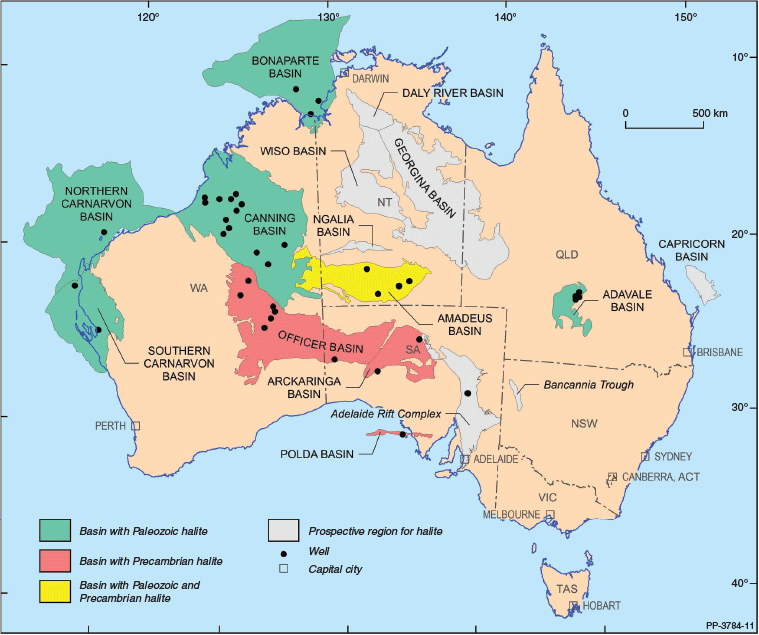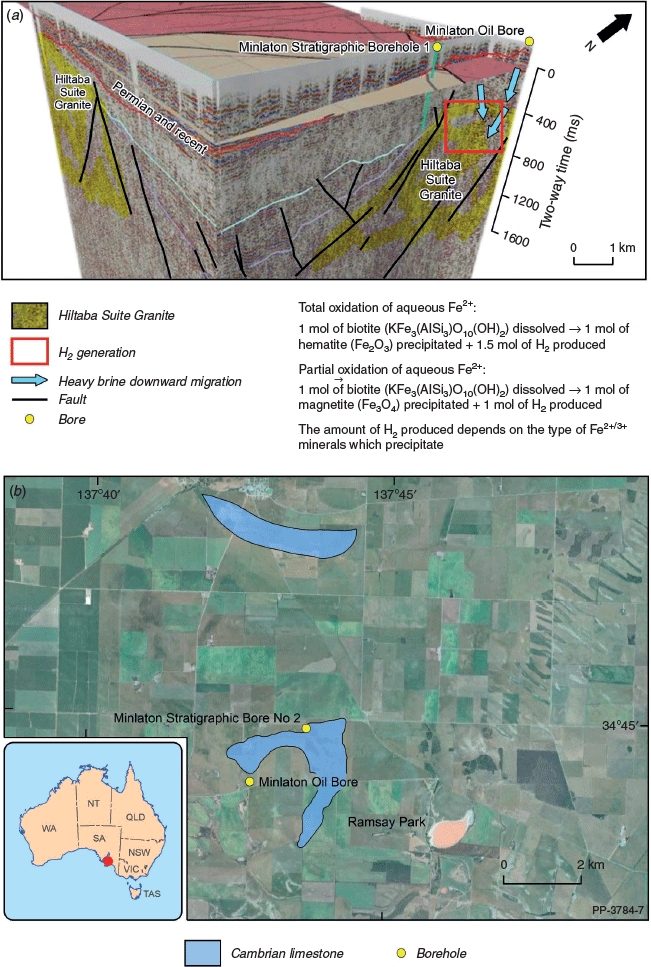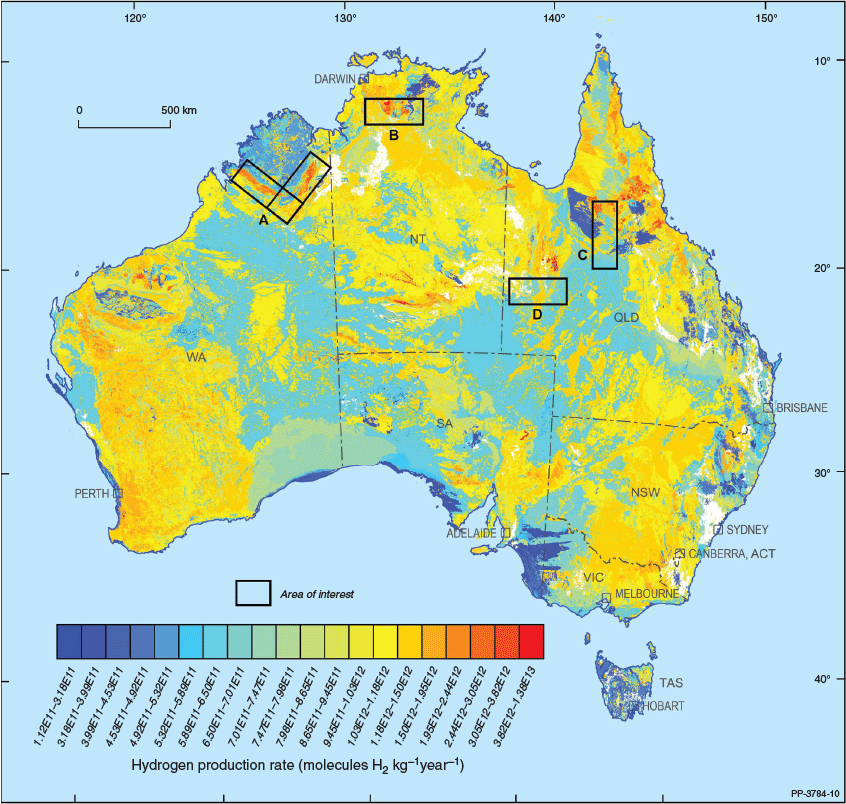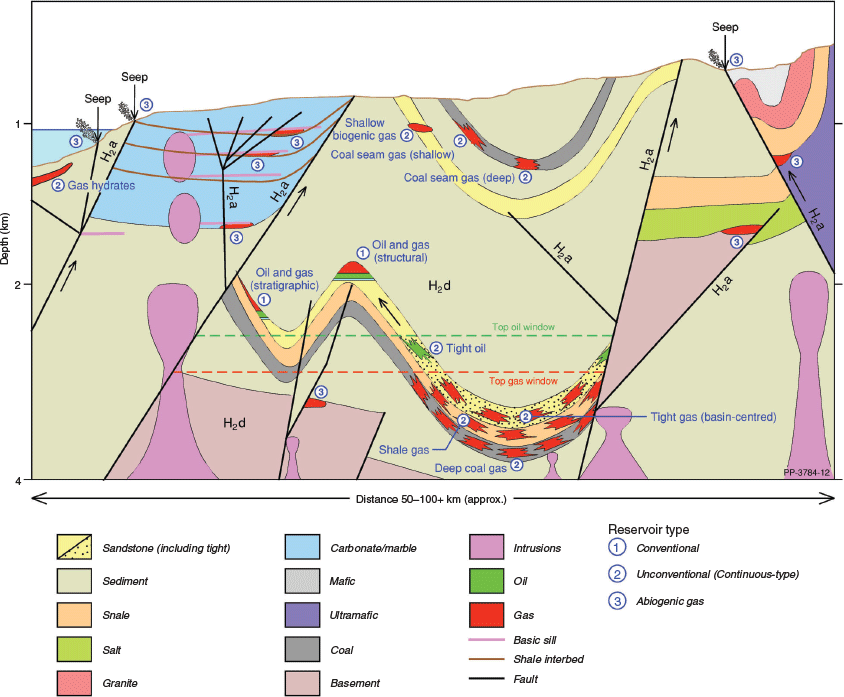Hydrogen in Australian natural gas: occurrences, sources and resources
Christopher J. Boreham A C , Dianne S. Edwards A , Krystian Czado B , Nadege Rollet A , Liuqi Wang A , Simon van der Wielen A , David Champion A , Richard Blewett A , Andrew Feitz A and Paul A. Henson AA Geoscience Australia, GPO Box 378, Canberra ACT 2601, Australia.
B Geological Survey of NSW, 516 High Street, Maitland NSW 2320, Australia.
C Corresponding author. Email: chris.boreham@ga.gov.au
The APPEA Journal 61(1) 163-191 https://doi.org/10.1071/AJ20044
Submitted: 3 February 2021 Accepted: 17 March 2021 Published: 2 July 2021
Journal Compilation © APPEA 2021 Open Access CC BY
Abstract
Natural or native molecular hydrogen (H2) can be a major component in natural gas, and yet its role in the global energy sector’s usage as a clean energy carrier is not normally considered. Here, we update the scarce reporting of hydrogen in Australian natural gas with new compositional and isotopic analyses of H2 undertaken at Geoscience Australia. The dataset involves ~1000 natural gas samples from 470 wells in both sedimentary and non-sedimentary basins with reservoir rocks ranging in age from the Neoarchean to Cenozoic. Pathways to H2 formation can involve either organic matter intermediates and its association with biogenic natural gas or chemical synthesis and its presence in abiogenic natural gas. The latter reaction pathway generally leads to H2-rich (>10 mol% H2) gas in non-sedimentary rocks. Abiogenic H2 petroleum systems are described within concepts of source–migration–reservoir–seal but exploration approaches are different to biogenic natural gas. Rates of abiogenic H2 generation are governed by the availability of specific rock types and different mineral catalysts, and through chemical reactions and radiolysis of accessible water. Hydrogen can be differently trapped compared to hydrocarbon gases; for example, pore space can be created in fractured basement during abiogenic reactions, and clay minerals and evaporites can act as effective adsorbents, traps and seals. Underground storage of H2 within evaporites (specifically halite) and in depleted petroleum reservoirs will also have a role to play in the commercial exploitation of H2. Estimated H2 production rates mainly from water radiolysis in mafic–ultramafic and granitic rocks and serpentinisation of ultramafic–mafic rocks gives a H2 inferred resource potential between ~1.6 and ~58 MMm3 year−1 for onshore Australia down to a depth of 1 km. The prediction and subsequent identification of subsurface H2 that can be exploited remains enigmatic and awaits robust exploration guidelines and targeted drilling for proof of concept.
Keywords: Australian craton, hydrogen exploration, hydrogen isotopes, natural gas, natural/native hydrogen, resource potential, serpentinisation, water radiolysis.
Introduction
Molecular hydrogen (i.e. H2) is the most energy-rich gas. The global energy sector is transforming and hydrogen is likely to play an increasingly prominent role as a clean energy carrier. Countries, such as Germany, Japan and South Korea, that are heavily reliant on imported fossil fuels, have identified hydrogen as a key pathway to decarbonise their transport, industry processes, heating and energy storage sectors (see FMEAE 2020, METI 2017 and MOTIE 2019, respectively). Fossil fuel exporting countries, such as Australia, have ambitions to develop large-scale hydrogen export industries (COAG Energy Council Hydrogen Working Group 2019; AusH2 2020). Hydrogen is almost exclusively manufactured for industrial use, with around 70 million metric tonnes (840 Bm3) per year being produced worldwide (Wood Mackenzie 2021). It can be produced artificially via a variety of different pathways (Nikolaidis and Poullikkas 2017) with the primary methods for production of hydrogen with low carbon emissions being (a) water electrolysis using renewable energy (green hydrogen), (b) steam reformation of natural gas paired with carbon capture and storage (CCS; blue hydrogen) and (c) coal gasification combined with CCS (also blue hydrogen) (Adolf et al. 2017; Bruce et al. 2018; Nuttall and Bakenne 2020). The majority of produced hydrogen originates from hydrocarbon-based feedstock without CCS (grey hydrogen) since the economics for the electrolytic production of green hydrogen (0.1% of total H2 production) requires improvement (Wood Mackenzie 2021). As of January 2021, there were over 50 hydrogen projects in development around Australia (AusH2 2020). For a large-scale hydrogen industry to develop, hydrogen storage is key. Hydrogen storage in salt caverns is considered the most promising approach for large-scale seasonal storage (HyUnder 2013; Caglayan et al. 2020). Examples of hydrogen storage in salt can be found in the United Kingdom (e.g. Teesside) and the United States of America (e.g. Clemens Dome, Spindletop and Moss Bluff). Hydrogen storage in depleted gas reservoirs is also being explored due to the greater spatial distribution of these underground geological resources, although impurity gases already contained within the gas field and reduction of sulfate to H2S remain potential problems (Amid et al. 2016; Flesch et al. 2018; Caglayan et al. 2020).
Hydrogen is seemingly ubiquitous in the subsurface, being classified as either natural or native or geological – trivial names are white (https://www.beceptum.com/projects/detail/white-hydrogen/) and gold (Pizzo 2020) hydrogen – (hereafter referred to as natural). Hence, hydrogen is an integral component of natural gas but it is not generally considered in the accounting of H2 resources for industrial usage (Nikolaidis and Poullikkas 2017). Moreover, it is important to understand H2 sources and inferred resources, and to identify and characterise new and potential occurrences of natural H2 from a geological perspective, as is highlighted herein by three case studies from the Australian continent. In the inventory of global H2 inferred resources, Australian H2 has been either under-represented (Truche et al. 2020; Zgonnik 2020) or not specifically estimated (Sherwood Lollar et al. 2014). Nevertheless, a recent multi-continent structural analysis of surface features that may indicate active H2 seepage has suggested that Australia is one of the most promising regions for future exploration for natural H2 (Moretti et al. 2021a). Our paper addresses deficiencies in the Australia-wide coverage, presents the H2 content of a large dataset of Australian natural gases, and gives a first-order estimate of H2 inferred resources from abiogenic sources. Our work also aims to assist with the development of a more robust H2 exploration guideline that recognises natural H2 as an increasingly attractive exploration target in Australia.
Geological occurrences, sources and sinks of natural H2
Natural hydrogen is present in a range of geological environments. For example, it occurs in crystalline basement, volcanic, ultramafic and peralkaline igneous complexes, geothermal and mineral systems, graphite, evaporite deposits and anoxic sediments, as well as in conventional and unconventional gas and oil fields, and coal seam gas (Gregory et al. 2019 and references therein). Hydrogen is recognised as a common component of natural gases (Goebel et al. 1984), although H2-rich (i.e. >10 mol% H2; Coveney et al. 1987) natural gases from sedimentary basins are rare (Smith et al. 2005; Zgonnik 2020). This is in part due to experimental/sampling bias because H2 concentration is not routinely analysed. Since H2 is mobile and chemically active, gases stored for millennia in reservoir rocks may require a continuous replenishment of H2 from disparate source(s) (Dubessy et al. 1989; Zgonnik 2020). Interestingly, H2 contents within gas and oil fields, in general, are commonly lower than surrounding rocks suggesting a chemical reaction between H2 and the emplaced organic matter (Zgonnik 2020).
Zgonnik (2020) classified natural H2 sources into two groups: primordial (primary) hydrogen stored within the earth’s hydridic core and mantle (Larin 1993; Walshe et al. 2005; Walshe 2006), and secondary hydrogen generated from chemical reactions within the mantle and crust. Natural H2 can be regarded as having either an abiogenic (Reeves and Fiebig 2020 and references therein) or a biogenic source, of which the latter includes both thermogenic (Tissot and Welte 1984; Hunt 1996) and microbial (Nandi and Sengupta 1998; Hallenbeck and Benemann 2002) processes. The isotopic signature of H2 can be used to help determine its origin. Fig. 1 shows the extensive range for δ2H H2 of around –850 to –100‰, depending on the processes involved during H2 liberation from secondary sources. Further, hydrogen isotopic equilibrium between H2, hydrocarbons and water can alter the δ2H of the initially generated H2. Nevertheless, serpentinisation and volcanism show the highest depletion and enrichment in 2H in H2, respectively.
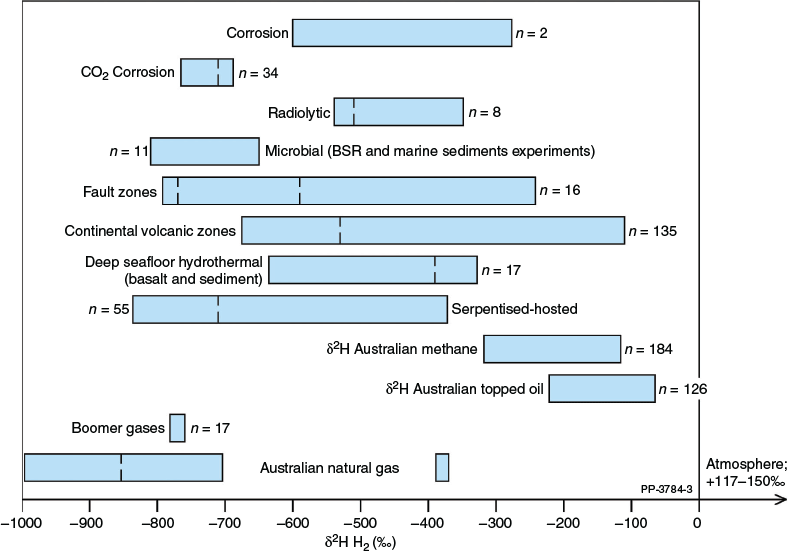
|
Primary source of H2
Hydrogen and helium (He) on earth have their roots in the formation of the universe and the solar system. Primordial H2 was initially captured then dissociated to form a hydritic core and lower mantle during the formation of the earth (Rumyantsev 2016), estimated to be some 4.54 billion years ago ±50 million years (National Geographic 2021). Some consider primary H2 resources infinite for human usage, if only accessible (Larin 1993; Zgonnik 2020; Moretti et al. 2021b).
Ultramafic rocks dominate the mantle and fluids in the lower mantle are likely to contain methane (CH4), H2 and water (H2O), whereas in the upper mantle they comprise carbon dioxide (CO2) and water. This primordial source of hydrogen is in the form of stored primary metal hydride and is considered the dominant form of hydrogen on earth (Zgonnik 2020 and references therein). These metal hydrides release H2 through processes resulting in the continuous and intermittently violent injections into the upper mantle and crust. Such large-scale fluid migration can have major impacts on all earth processes within the upper lithosphere, biosphere, hydrosphere and atmosphere (Walshe et al. 2005; Walshe 2006).
Secondary sources of H2
Abiogenic sources of natural hydrogen are potentially the largest yet-to-find resources, although exploration for petroleum and the recovery of biogenic natural gas (with non-commercial H2) is the largest currently exploited resource. Abiogenic H2 might influence crustal redox chemistry that control deposition of ore mineralisation (Walshe et al. 2005; Zgonnik 2020), and hence the analysis of gases from mines would be beneficial (Boreham et al. 2021).
Abiogenic sources
Numerous abiogenic sources of natural H2 are summarised in Table 1, with serpentinisation, radiolysis and volcanic and hydrothermal vents being considered some of the most important geological processes. Fluid–rock interactions involving the generalised reactions with ferrous iron (Fe2+):H2 stoichiometry of 3:1 (Eqn 1) and 2:1 (Eqn 2) (Holland 2002; Sleep and Bird 2007) follow:


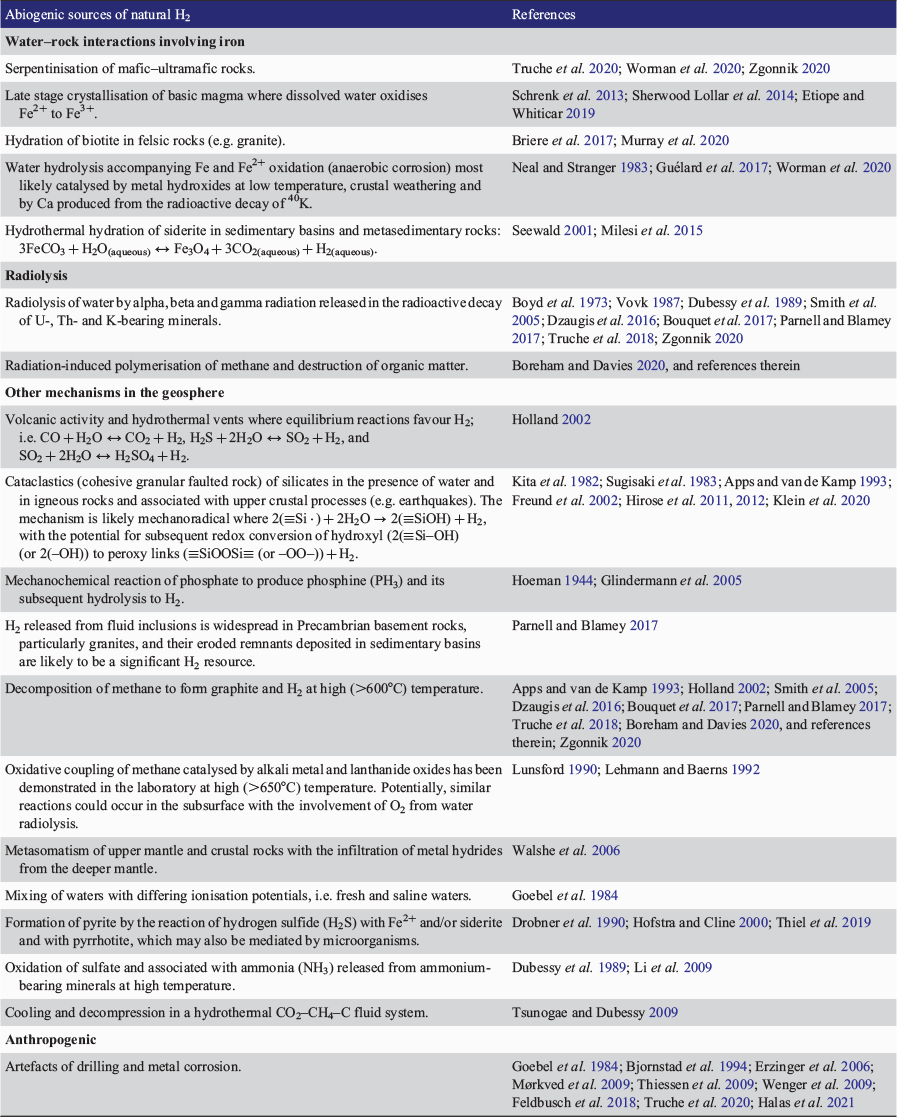
|
Serpentinisation is the most studied reaction pathway to H2 in the subsurface (Table 1) and is discussed here in more detail. Serpentinisation occurs with the circulation of hydrothermal fluids through mafic–ultramafic rocks on the seafloor at deep-sea hydrothermal vents and in continental ophiolites. In the serpentinisation of fayalite (Fe-olivine end-member), Eqn 1 is followed liberating H+. In general, with increasing magnesium (Mg) content in olivine and Mg-silicates, the resulting fluids often become alkaline (Holland 2002). Thus, hydrous alteration of minerals such as olivine and pyroxene produces serpentine, brucite, magnetite and H2 (Eqn 3; McCollom and Seewald 2013; Worman et al. 2016) while still maintaining Fe:H2 in a 3:1 ratio.

Serpentinisation can occur at temperatures from just above ambient to 330–400°C, depending on pressure (Evans et al. 2013; Mayhew et al. 2013; McCollom and Seewald 2013). The mantle lithosphere could also support serpentinisation (Brovarone et al. 2017). Low temperature (<100°C) H2 production is associated with a spinel reactant (e.g. M2+(M3+)2O4; magnetite Fe3O4 and chromite FeCr2O4) and a cubic crystal structure. The spinel can either be as impurities in the initial reactant or the serpentinisation product (Mayhew et al. 2013). Hydrogen yield from serpentinisation is directly linked with the fraction of reduced iron in the reactant mineral (e.g. olivine or pyroxene with variable Fe/Mg ratios) and the proportion converted to Fe3+ (McCollom and Seewald 2013; Murray et al. 2020). Given the stoichiometry between H2 and magnetite production, the lower magnetite (and associated H2) yield in the early stages of serpentinisation is likely offset by release of Fe2+ into the hydrothermal fluid where it is available for water hydrolysis (see below) (Cannat et al. 2010). The aqueous chemistry of Fe2+ is also likely to play an important role, for example, Fe(OH)2 may disproportionate to Fe and magnesite with the subsequent hydrolysis of the Fe liberating H2 (Blesa and Matijević 1989). A critical factor for serpentinisation is a highly reducing environment, i.e. below the low O2 fugacity/high H2 activity associated with the fayalite–magnetite–quartz buffer (Shock et al. 2019 and references therein). Such redox conditions are likely to be maintained in rock-dominated environments where oxidising meteoric water recharge is restricted (Abrajano et al. 1990) and silica activity is low (Katayama et al. 2010). The discharged aqueous fluids change from highly alkaline to moderately acidic with increasing temperature (McCollom and Seewald 2013; Schrenk et al. 2013; Murray et al. 2020) with the high temperature fluids having highly elevated H2 and CH4 concentrations (Schrenk et al. 2013). Serpentinisation of ultramafic rocks typically generate higher concentration of H2 than basalt–water reactions (Hao et al. 2020). For example, Fe2+ is excluded from the ultramafic-altered minerals while basalt-altered minerals (e.g. chlorite and amphibole) readily accommodate Fe2+ (Murray et al. 2020). Serpentinisation is likely limited to the shallow crust i.e. the upper ~4–6 km corresponding to the 400°C isotherm (Andreani et al. 2007), although optimum temperature-depth for serpentinisation reaction is likely around 10 km (Donze et al. 2020).
In felsic rocks (e.g. granites), biotite can also hydrate to generate H2 (Table 1). Here, the lower proportion of this Fe2+-rich mineral compared to the proportions of Fe2+-minerals in basic rock makes granites a less effective source of H2 compared to mafic–ultramafic rocks on a volume per volume basis (however, see Case study 2). Nevertheless, high redox potentials, low temperatures and the addition of CO2 can increase H2 yield from granites (Murray et al. 2020).
Radiolysis of water (Table 1) in the geosphere is another significant mechanism of generating natural H2 that is amenable to modelling and resource estimation (Sherwood Lollar et al. 2014; Warr et al. 2019; Boreham et al. 2021; also see H2 inferred resource potential of onshore Australia) employing the reaction:

Interestingly, the H2 yield from water radiolysis is suppressed in the presence of metal ions (Fe2+ and Fe3+) compared to pure water (Christensen and Bjergbakke 1982). However, even in basic rocks with lower radiogenic minerals contents, radiolytic splitting of water is considered providing more electron donors than Fe2+ in old (>10 Ma) basement basalt (Dzaugis et al. 2016). Depth limits to water access is likely to be around 10 km where rock fractures anneal and H2O flow is significantly retarded (Oze and Sharma 2005; Sherwood Lollar et al. 2014).
Zgonnik (2020) considers volcanic and hydrothermal vents to be the most dominant H2 source, having the highest estimated natural H2 production rates. Further, a cataclastic source (Table 1) of natural H2 is also unconstrained, with estimates of H2 production rates ranging up to many orders of magnitude greater than from serpentinisation and water radiolysis combined (Ménez et al. 2019; Truche et al. 2020; Worman et al. 2020; Zgonnik 2020). Parnell and Blamey (2017) suggest that H2 released from fluid inclusions is widespread in Precambrian basement rocks, particularly granites, and their eroded remnants deposited in sedimentary basins, and hence, a likely significant H2 resource. Artificial H2 production associated with drilling operations and metal corrosion (Table 1) typically give low concentrations of H2 (Erzinger et al. 2006) but occasionally high concentrations (up to 90 mol%) can be produced (Mørkved et al. 2009; Thiessen et al. 2009; Guélard et al. 2017). A hydridic source from the lower mantle and core are theorised to be the ultimate largest ‘H’ reservoir (Zgonnik 2020, and references therein), where H2 can either continually migrate upwards or be released with episodic injection into the upper mantle/crust where the metal hydrides can undergo metasomatism and water hydrolysis (Table 1).
Biogenic sources
Biogenic sources of natural hydrogen include both thermogenic and microbial origins. In the former, H2 is a by-product of diagenesis and thermal maturation, while in the latter, H2 producers and H2 consumers generally work in consortia (Boone et al. 1989; Noar et al. 2015; Gregory et al. 2019) and provide an important H2 sink (see H2 sinks below).
During diagenesis, the polymerisation of hydrocarbon C–C bonds results in the formation of kerogen and minimal release of H2. Thermogenic liberation of H2 occurs during subsequent catagenic scission of hydrocarbon C–C bonds during the generation of gas and oil, coal seam gas (Gregory et al. 2019, and references therein) and petroleum cracking (Briere et al. 2017). During metagenesis, the progressive aromatisation of the residual kerogen also leads to production predominantly of CH4 but also some H2 (Tissot and Welte 1984; Hunt 1996). Thermolysis of alkanes and CH4 at >200°C and >500°C, respectively (Tissot and Welte 1984) also result in the release of H2.
H2 sinks
Hydrogen sinks within the lithosphere–hydrosphere–atmosphere are such that H2 excess over geological H2 sinks is effectively utilised either by microbes or their enzymic by-products (Sleep and Zoback 2007; Ehhalt and Rohrer 2009; Worman et al. 2020). This leads to a balance between source and sink that helps maintain a relatively steady-state atmospheric H2 concentration at trace levels of ~0.5 ppm (Ehhalt and Rohrer 2009; Batenburg et al. 2011). Soil uptake by carbon and abiontic enzymes (i.e. catalytic enzymes stabilised in the soil matrix but that are no longer associated with viable cells) is considered the major H2 sink (Nannipieri et al. 2018). Deep earth H2-utilising microbes (e.g. associated with the biodegradation of petroleum and production of microbial CH4), H2 dissolved in water and consumption by abiotic reactions (e.g. oxidation by OH) are volumetrically, at best, estimated to be around an order of magnitude lower than the H2 soil sink (Ehhalt and Rohrer 2009, 2011; Truche et al. 2020; Worman et al. 2020; Zgonnik 2020). Due to the high reactivity of H2, reservoired petroleum can act as a potential sink with hydrogenation improving hydrocarbon quality and volume, masking any H2 input. Further, organic-rich rocks within the hydrocarbon generation zone are even considered an impenetrable sink via chemical reaction (Apps and van de Kamp 1993).
Global resource estimates of natural H2
Primary abiogenic H2 within the lower mantle is considered to be widely distributed but volumetrically unknown, while the upper mantle–crust has an estimated mostly secondary H2 annual production rate of around 254 ± 91 Bm3 (8.97 ± 3.21 Tcf) year−1 (Zgonnik 2020). Another recent estimate gave a much lower global H2 resource of 31 Bm3 year−1 (1.1 Tcf) from continental and oceanic crust sources, water radiolysis, volcanism and volcanic degassing (Truche et al. 2020). In the above two estimates, the H2 production rate from cataclasis (rock fracturing; see Geological occurrences, sources and sinks of H2) is grossly under-represented (Hirose et al. 2011, 2012; Parkes et al. 2019). Zgonnik (2020) combined data from the Western and Eastern (former Soviet bloc) literature to conclude that global H2 occurrences have been under-estimated. Nevertheless, the most optimistic H2 resource estimate is still lower than the industrial H2 production and is around two orders of magnitude lower than the 4.1 Tm3 (145 Tcf) of natural gas production in 2019 (IEA 2019). Even the atmospheric load of 1.7 Tm3 (Truche et al. 2020) would not sustain increasing global H2 demands, unlike the large atmospheric potential for He extraction (Boreham et al. 2018 and references therein). Although the above annual production rates of natural H2 are underwhelming, it must be taken into account that abiogenic H2 production is relatively continuous for millions to billions of years and over a wide temperature range (Zgonnik 2020 and references therein), unlike petroleum generation with shorter timespans within specific narrow temperature windows (Tissot and Welte 1984; Hunt 1996). Reserves of natural H2 from petroleum fields are modest, estimated to be around 20 Bm3 using 197 Tm3 of global natural gas proven reserve (BP 2019) and an average H2 content of around 0.01 mol%. The recent discovery of abiogenic H2-rich over-pressurised gas (97.4 mol% H2) from the shallow Bougou 1 well, in the Southern Taoudeni Megabasin, Mali, West Africa, has resulted in small-scale gas production for electricity generation (Briere et al. 2017; Prinzhofer et al. 2018). There is a strong appetite for continued niche H2 exploitation and for natural H2 to be directly blended – up to initially 10% hydrogen by volume – in gas distribution networks (Melaina et al. 2013; COAG Energy Council Hydrogen Working Group 2019). Hence, the prediction of subsurface H2 that can be exploited remains enigmatic and awaits a wider range of viable analogues and robust exploration guidelines.
H2 in Australian natural gas
Historically, there are a few reports of H2-rich (>10 mol% H2) Australian natural gases (Fig. 2). For example, up to 89 mol% H2 (air-free) gas was analysed in shallow bores on the Yorke Peninsula and Kangaroo Island, South Australia (Ward 1917, 1932, 1933, 1944; Woolnough 1934; see Case study 2). Dissolved gases in artesian groundwaters from the Mesozoic Great Artesian Basin in eastern Australia recorded around 16 mol% H2 and variable CH4 content (Woolnough 1934). With the advent of extensive petroleum exploration programs and with ad hoc inclusion of H2 in the chemical analysis of natural gases, other instances of high hydrogen concentrations have been reported across the continent. While drilling in sedimentary rocks in the Canning Basin, Western Australia (WA) in 1958, Meda 1 recorded up to 95 mol% H2 (https://wapims.dmp.wa.gov.au/WAPIMS/Search/Wells), and 38.2 mol% H2 was measured in Golden Beach 1 drilled in 1967 in the Gippsland Basin, Victoria (http://geoscience-web.s3-website-ap-southeast-2.amazonaws.com/well/goldenbeach1.htm). In Tasmania, Lonnavale 1 encountered 85 mol% (air-free) H2 (Burrett and Tanner 1997). A degree of caution concerning the validity of these historic geological sources needs to be applied to these archival H2-rich gases given the prevalence of H2 artefacts from drilling operations (Table 1), and where re-sampling and analysis using current technologies is recommended.
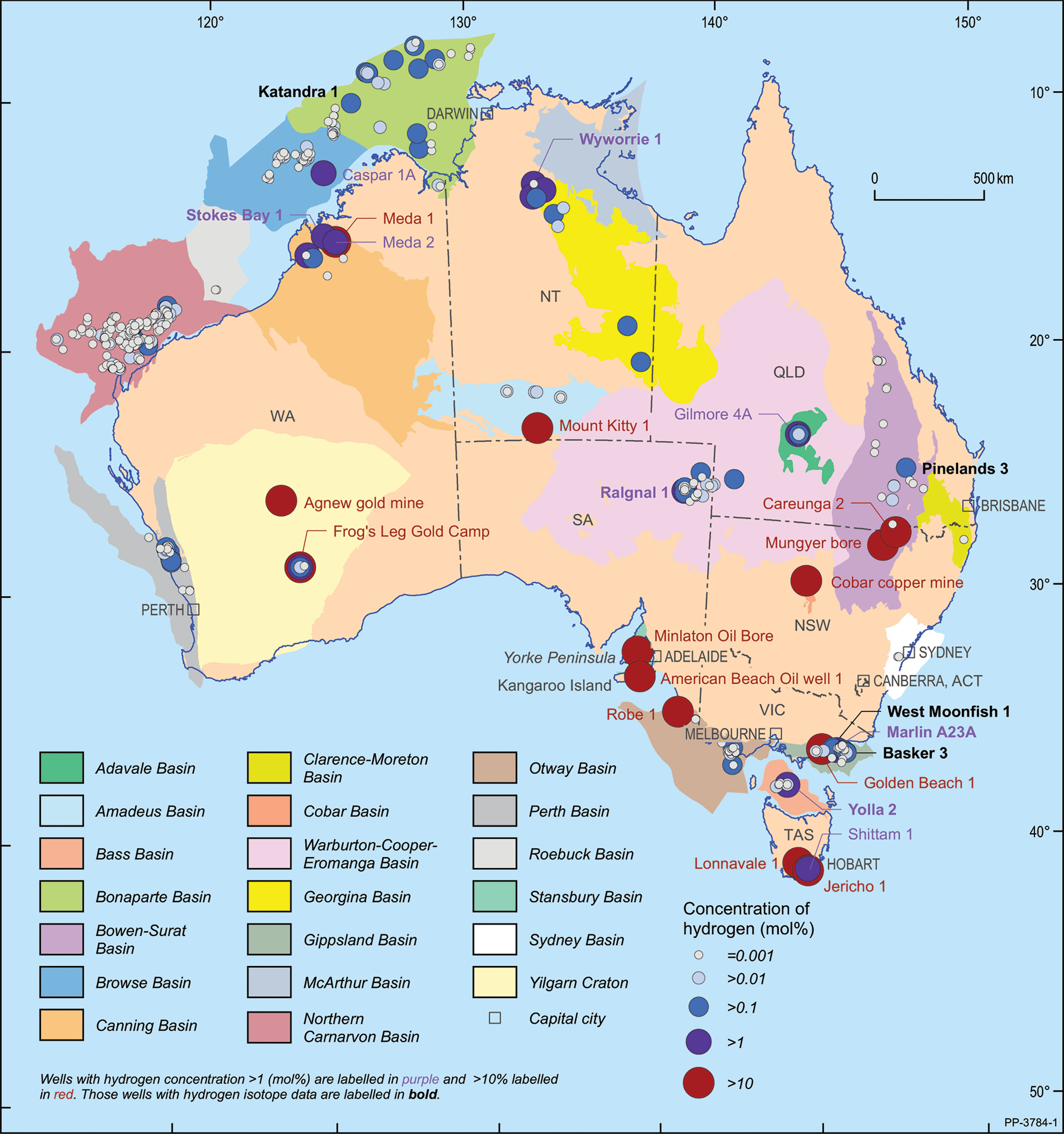
|
In a compilation of Australian natural gas data from petroleum exploration wells, Boreham et al. (2001) proposed that gases with elevated H2 contents have mixed origins from a deep inorganic source and from organic matter (kerogen) decomposition at high maturities. In Australia, past petroleum exploration activities have been typically focused on sedimentary basins with little penetration into, for example, fractured basement rocks where abiogenic hydrocarbons and H2 most likely originate and potentially accumulate (Etiope and Whiticar 2019, and references therein; Zgonnik 2020, and references therein). Nevertheless, high concentrations of H2 (11 mol%; McInnes et al. 2017) were discovered in Precambrian basement at the Mt Kitty 1 exploration well, Amadeus Basin, Northern Territory in 2015. Further, mud gases (collected in Isotubes™) analysed after the 2013 drilling of Wyworrie 1 (McArthur Basin, Northern Territory) contained H2 up to 11.7 mol% (air-free) in the shales of the Precambrian Velkerri Formation (https://geoscience.nt.gov.au/gemis/ntgsjspui/handle/1/79187).
Notwithstanding the above limited occurrences of H2-rich gas, natural H2 might yet be found in depositional settings not previously considered suitable for petroleum exploration (Coveney et al. 1987). For example, in recent ore mining operations, H2-rich gases have been found at the Cobar copper underground mine, New South Wales (~75% H2 and ~25% CH4; Stack and Rabone 2018) and up to 61.7 mol% (air-free) at the Boomer deposit, Frog’s Leg Gold Camp, Eastern Goldfields Superterrane, WA (Boreham et al. 2021; see Case study 3).
Geoscience Australia’s Isotope and Organic Geochemistry Laboratory routinely analyses onshore and offshore Australian natural gases. Of these, ~1000 natural gases from 470 wells with reservoir rocks ranging in age from Neoarchean to Cenozoic have H2 contents above the detection limit of 0.0002 mol% and up to 91.9 mol% (air-free) (for experimental procedure see Boreham et al. 2021). The well locations of these gases are shown in Fig. 2, while the frequency distribution of H2 mol% together with the data for Western Australian gold deposit gases and H2-rich natural gases from Ward (1917, 1933) are shown in Fig. 3a. The H2 mol% (air-free) frequency mode for the Australian natural gases is between 0.001 and 0.01 mol%, indicating that H2 mol% is very low in natural gas. Having said this, there are enough examples of H2 >0.1 mol% to warrant further investigation and to recommend that future analysis of H2 in natural gases becomes a routine exploration industry-wide practice.
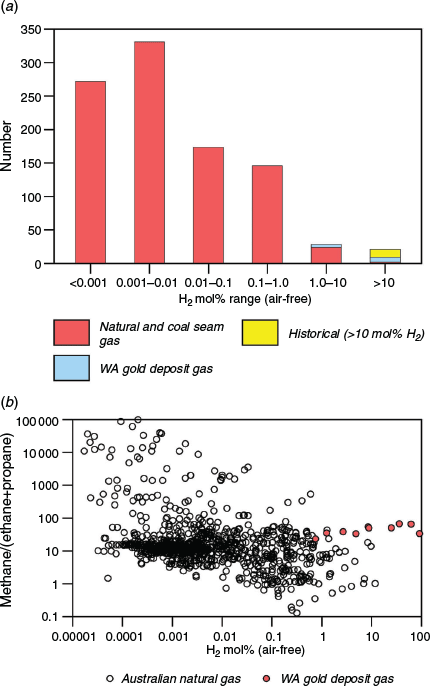
|
The plot of H2 mol% (air-free) versus C1/(C2 + C3) ratio in Australian natural gases shows a general decrease in the ratio with increasing H2 mol% (air-free) (Fig. 3b). The WA gold deposit gases are generally drier (higher C1/(C2 + C3) ratio) than Australian natural gases with similarly high H2 mol% (air-free). These WA gold deposit gases have C1/(C2 + C3) ratios of 23–67, typical of abiogenic gas (Etiope and Ionescu 2015 and references therein).
The hydrogen isotopes (δ2H in ‰) of selected Australian natural gases with H2 contents between 0.58 and 6.91 mol% (for experimental procedures see Boreham et al. 2021) is given in Table 2 and their range displayed in Fig. 1, together with the hydrogen isotopic range of H2 sources from a variety of geological and biological sources and artefacts (i.e. iron corrosion). The δ2HH2 values for Australian natural gases cover a very wide H-isotopic range from –995.9 to –388.8‰ (Table 2), with the former value being the most 2H-depleted H2 so far presented in the literature. There is no overall correlation between H2 mol% and δ2HH2, although the isotopic range is narrower for H2 content >2 mol% with δ2HH2 average = 793 ± 62‰. These values are consistent with migrated H2 derived from serpentinised sources. The two gases with δ2HH2 –388.8‰ (Pinelands 3, Surat Basin) and –369.6‰ (Katandra 1, Bonaparte Basin) (Table 2) are likely sourced from volcanics and/or water radiolysis. However, given that natural gas with extreme depletion in 2H is unusual compared to known sources (Fig. 1), these values may point to an artefact accompanying gas production and/or collection and/or storage in stainless steel cylinders and Isotubes™; this needs further experimentation. Using the accompanying hydrogen isotopes of CH4 (δ2HC1) and assuming isotopic equilibrium between CH4 and hydrogen, the calculated (with extrapolated) equilibrium temperatures are listed in Table 2. Such extremely low and high calculated temperatures show that there is neither an association nor isotopic equilibrium between the generation of CH4 and hydrogen, and the sources of H2 remain highly speculative in the present limited sample set. Given that the sample collection medium and the timing of analysis are considered important (Goebel et al. 1984) (e.g. hydrogen isotopic analysis of H2 at Geoscience Australia was years after sample collection with storage mainly in stainless steel cylinders), protocols for the measurement of accurate H2 content and hydrogen isotopes of H2 in natural gas need to be expedited.
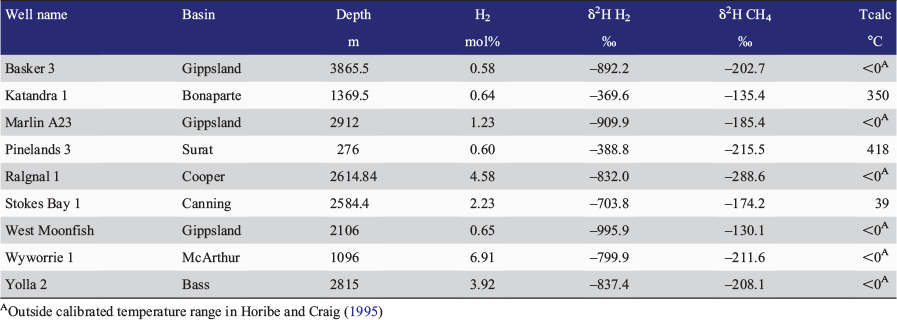
|
The H2 system
Hydrogen has had a ubiquitous presence since the earth was formed with potentially extreme concentration in the very early atmosphere (up to 30 mol% H2; Wordsworth and Pierrehumbert 2013) to a relatively pseudo steady-state present-day concentration (av. 5.31 × 10−5 mol%; Novelli et al. 1999) where atmospheric input, from mainly surficial and aerial chemical processes (Adushkin et al. 2006) is balanced by atmospheric loss into the upper atmosphere and into space (Zgonnik 2020 and references therein). Abiogenic H2 is a source of energy for chemotrophic ecosystems and may have contributed to the development of early life on earth (Ménez 2020 and references therein) and other planets in our solar system (Glein and Zolotov 2020 and references therein). Soil is the major sink for H2 so this can mask geologically supplied inputs. Where point source outweighs sink, then H2 seepage occurs which can be a positive indicator of subsurface H2 systems. The large isotopic enrichment in 2H in tropospheric H2 (Fig. 1) compared to other terrestrial occurrences is predominantly associated with 2H/1H isotopic fractions of atmospheric OH-induced destruction of H2 and generation of H2 from CH4 photolysis (Ehhalt and Rohrer 2009; Batenburg et al. 2011).
Petroleum system concepts of source–migration–reservoir (alteration)–seal developed for conventional natural gas are valid for abiogenic gas but appropriate exploration guidelines will need significant updating (see Towards an H2 exploration guideline) if the commercial success of abiogenic H2 is to be realised. For example, for an organic-rich source rock, the timing of thermogenic petroleum generation (gas and oil) is governed by the time-temperature history and the organic matter (kerogen) type (Tissot and Welte 1984). Sulfur-rich kerogen generates petroleum at a lower temperature than does sulfur-poor kerogen (Tegelaar and Noble 1994). This could be considered analogous to Fischer–Tropsch type gas-phase reaction of H2 with CO2 (Sabatier reaction) producing hydrocarbons where rhodium- and ruthenium-rich minerals catalyse the reaction at lower temperatures than iron-, chromium- and nickel-containing minerals (Etiope and Whiticar 2019 and references therein). Additionally, serpentinisation can lead to increased porosity, transforming a tight mantle rock into a potential reservoir (Smith et al. 2005).
Migrating hydrogen and gaseous hydrocarbons do not necessarily co-concentrate (become trapped) below the same migration barriers. For example, H2 is trapped by aquifers (Dugamin et al. 2019) and igneous rocks are effective seals for H2, where this is not the case for natural gas. In contrast, thick carbonates retain hydrocarbon gases better than H2 (Prinzhofer et al. 2018). Clay minerals can be an effective adsorbent of H2 (Truche et al. 2018). Hydrogen can be trapped either within or below evaporite seals (Smith et al. 2005). Salt can also act as a buffer withstanding reservoir breaching during prolonged periods of tectonic activity (Johns et al. 2017). Even more effective H2 trapping can occur in alternating layers of salt and clay (Zgonnik 2020). Evaporites are distributed across many Australian sedimentary basins and intersected in numerous wells, as shown in Fig. 4 (Wells 1980; Australian Occidental 1982; Mory 1988, 1991; Felton et al. 1993; Plescia et al. 1994; Simeonova and Apak 2003; Simeonova and Iasky 2004; Kovalevych et al. 2006; Gill and Cowan 2008; Korsch and Kositcin 2010; Carr et al. 2012; Bruce 2015; Gill 2017; Mory 2017; Haines and Allen 2020). Halite-bearing formations were formed during the Neoproterozoic in the Amadeus, Officer, Polda, Arkaringa and Stansbury basins, and in the Paleozoic in the Adavale, Amadeus, Canning, Carnarvon and Bonaparte basins (Fig. 4).
There are many examples of a close association of H2 anomalies with faults, most likely accessing crystalline basement (Larin et al. 2015, and references therein; see Case studies 2 and 3), where the latter is considered a significant geological source for H2 and He (Flude et al. 2019). Potential locations of H2 sources can be associated with mineral deposits, remotely identified using geophysical techniques (gravity and magnetic anomalies) (Dugamin et al. 2019; see Case study 1). Additionally, the surface expression of subsurface H2 source rocks is commonly characterised by rounded to oval depressions observed from satellite imagery (Zgonnik 2020 and references therein; Moretti et al. 2021a). These characteristic surface expressions have been identified at Pingrup, WA (Larin et al. 2015) and more widely across southern WA and southern South Australia (Rezaee 2020; Moretti et al. 2021a) and may be indicators for deeper H2 sources. A major advantage for H2 derived from an abiogenic source compared to petroleum generated from an organic carbon-based (biogenic) source is that the former can be generated continuously over a longer timeframe and a wider temperature range.
Case studies
Three case studies are presented below designed to highlight important attributes of surface to subsurface geochemical, geological and geophysical methodologies that should be utilised together, or in part, to understand potential H2 systems with increasing levels of confidence. Case study 1 is in the South Nicholson Basin, a vast frontier area that crosses the Northern Territory–Queensland border and for which gas compositional data are not available but has active exploration and stratigraphic drilling programs. Here, H2 potential is inferred from rocks of similar age in the adjacent Beetaloo Sub-basin of the McArthur Basin where high-H2 gases were found in natural gas from Wyworrie 1 (Fig. 2). Case study 2 is in southern South Australia where a H2 ‘hot spot’ was identified in the early 20th century within sedimentary rocks of the Stansbury Basin overlying Archean basement rocks of the Gawler Craton, but not examined thereafter. Case study 3 is in the Western Australian Archean Yilgarn Craton, Eastern Goldfields Superterrane and close to the township of Kalgoorlie, where recent chemical and isotopic analyses of H2-rich and CH4-rich natural gases have allowed the delineation of their abiogenic sources (Boreham et al. 2021).
Case study 1: South Nicholson Basin, Northern Territory
This case study focuses in the South Nicholson Basin where Geoscience Australia has acquired new deep-crustal reflection seismic data (Carr et al. 2020; Fomin et al. 2020) to assess the hydrocarbon and mineral resources potential between two prospective Paleoproterozoic provinces: the Mt Isa Province to the southeast and the McArthur Basin to the northwest. The new seismic data linked the stratigraphy with correlation of prospective stratigraphic units across the region, including the Isa and Roper superbasins and South Nicholson Group (Fig. 5). The recently completed drilling at Carrara 1 (MinEx CRC 2020) aims to stratigraphically correlate key rock units to the seismic packages and compositional analyses will be performed on the recovered gas and gas released from fluid inclusions. The Isa Superbasin is largely concealed beneath the region and includes rocks that are prospective hosting the world class Mount Isa Cu-Pb-Zn deposit and a number of other regional base metal deposits (Fig. 5a). Recent exploration for unconventional hydrocarbons in the northern Lawn Hill Platform (NW Mt Isa Province) identified gas in the organic-rich shale units of the Lawn and River supersequences (Bradshaw et al. 2018), demonstrating significant unconventional potential in the underexplored Isa Superbasin. These Mt Isa Province and McArthur Basin prospective regions are underlain by the edge of thick lithosphere. The global Lithosphere–Asthenosphere Boundary reveals a striking relationship between major sediment-hosted mineral deposits and the edge of the thicker lithosphere, as outlined by the 170 km depth contour (Czarnota et al. 2020; Hoggard et al. 2020). Major pre- to syn-Paleozoic faults and shear zones of the North Australian Craton wrap around blocks of thick lithosphere, indicating that they have influenced strain partitioning and ore forming processes through multiple tectonic cycles (Czarnota et al. 2020).
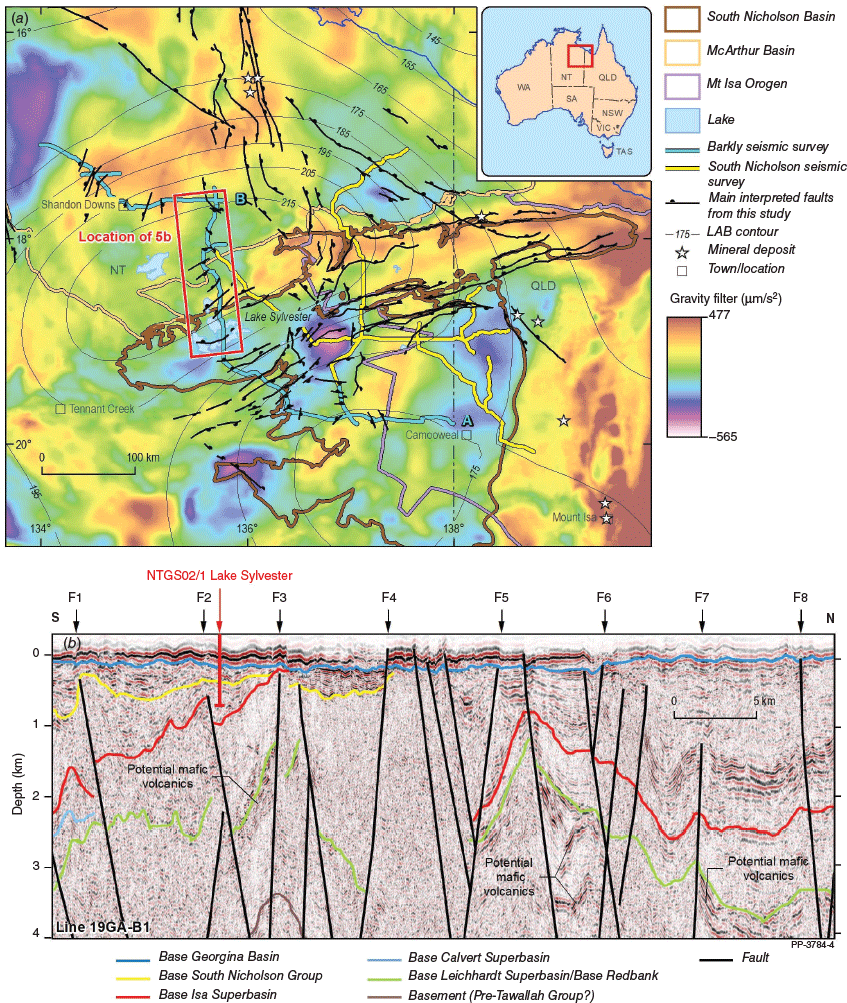
|
The integration of gravity (Fig. 5a) and magnetic anomaly lineaments with deep seismic reflection data allows the mapping of pre-existing major crustal structures that have controlled the basement architecture and subsequent basin’s evolution (Rollet et al. 2020). These major crustal structures provide potential conduits for large-scale, paleo-fluid migration, some being inferred to be prospective for sediment-hosted base metal deposits most likely sourced from mafic igneous rocks hosted within the early sedimentary basin fill (Fig. 5b: Paleoproterozoic Leichhardt and Calvert superbasins). Magnetotelluric data collected across the region reveal anomalous conductivity structures that extend from deep within the lower crust to the uppermost crust (Duan et al. 2020; Jiang et al. 2020). These conductive structures are interpreted to represent fluid conduits that altered/hydrated the crust. They are prospective for iron oxide–copper–gold (IOCG) deposits and have been the focus of many recent investigations (Czarnota et al. 2020; Murr et al. 2020; Schofield et al. 2020). Such zones, considered to be the most favourable areas for potential mineralisation and H2 sources, correlate with magnetite and hematite alteration proxies using 3D gravity and magnetic inversion (Goodwin and Skirrow 2019), as well as major crustal structures and edges of basement highs (Rollet et al. 2020) (Fig. 6a).
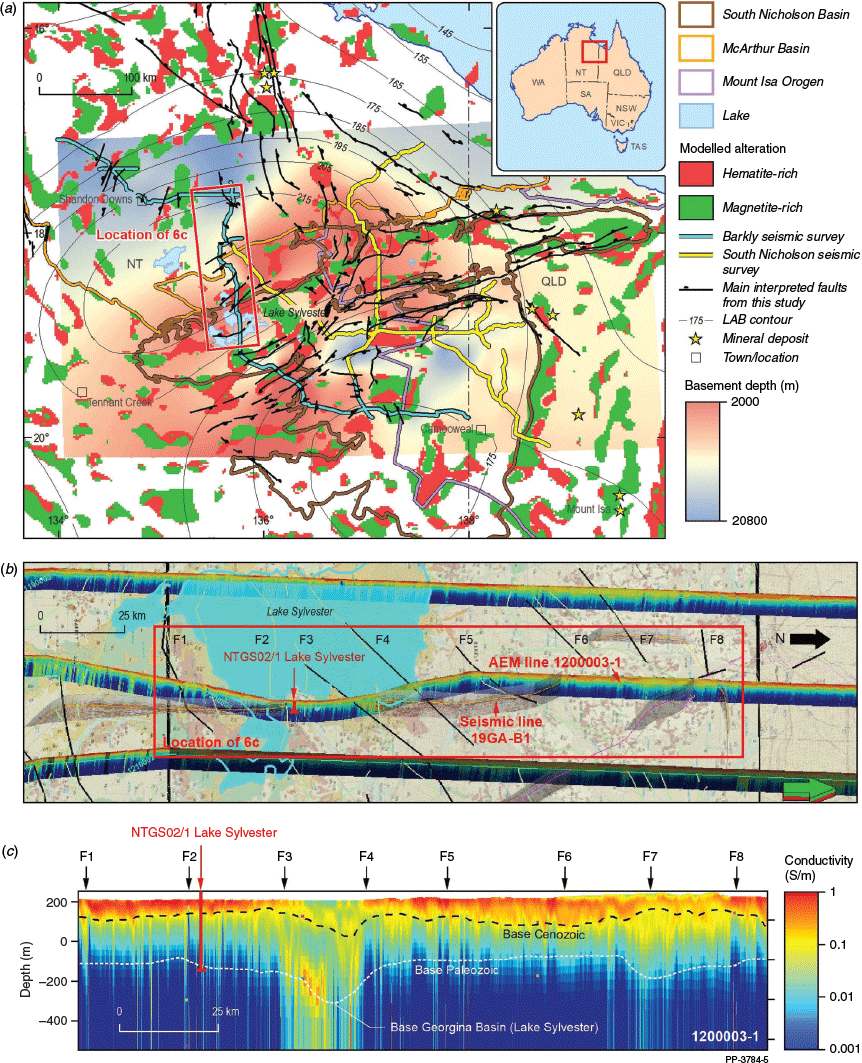
|
Further investigation in this area could help better understand the potential relationships between structural and mineralogical elements that are observed elsewhere in intra-cratonic basins and are associated with natural H2 migration from deep-seated sources. Donze et al. (2020) have demonstrated the relationship between H2 occurrences and other geological elements, such as (i) a relatively high geothermal gradient, (ii) deep faults delineating horst and graben structures, which affect the entire sedimentary sequence and (iii) Archean to Paleoproterozoic basements enriched in radiogenic elements and displaying mafic and ultramafic units. Furthermore, salt lakes exist (Fig. 6b) between these conducive areas for mineralisation and hydrocarbon generation, that have up to 20 times more enrichment in potassium (K) compared with sea water (Mernagh et al. 2016). This K enrichment enhances H2 generation potential from the hydrolysis of water by Ca from the 40K radioactive decay (see Geological occurrences, sources and sinks of H2) in areas where ancient salt lakes are deeply buried and there is a possible karst reservoir-seal (i.e. Middle Cambrian limestone within the Georgina Basin overlying the Paleoproterozoic provinces) located 400 m below the surface (Fig. 6c).
Case study 2: Gawler Craton-Stansbury Basin, SA
This case study focuses on the central Yorke Peninsula in South Australia (Fig. 2) where multiple hydrogen gas discharges were observed during drilling of the Minlaton Oil Bore (Ward 1944). The Minlaton Oil Bore (Fig. 7a) was drilled in 1931 (recorded as the Ramsay Oil Bore 1 in the SARIG database; https://map.sarig.sa.gov.au/) and is located ~10 km east of the Minlaton township within map section 112 Ramsay (Fig. 7b). The first gas show was recorded in the sludge below 370 ft (112.78 m). Three gas samples were collected from the bailer at the surface from the following depths: 790 ft (240.79 m), 860 ft (262.13 m) and 1666 ft (507.8 m). They revealed significant H2 content of 76, 64.4 and 84 mol%, respectively, with nil to minor CH4 (7.5, 7 and 0 mol%, respectively) and nil to minor air contamination (based on 0, 2.4 and 1.2 mol% oxygen, respectively) with the balance being nitrogen and ≤0.8 mol% CO2. There are no wireline logs available for the Minlaton Oil Bore. Visitors to the site on 21 September 1931 described one of the hydrogen gas influxes:
After the slush pump was raised to the surface it would then begin to bubble getting stronger and stronger until it resembled a boiling pot with fine spray jumping clear out of the water 5 to 6 inches above the surface of the water. It also raised the water in slush pump 4 to 5 inches and cause it to overflow the gas thus displacing 4 to 5 inches of space. It also had a rainbow colouring vily# scum on water and would ignite the bubbles with a match and in one instance the flame shot all over the full surface of the slush pump it was so strong. At times an odour like carbide could be positively detected.
#Likely a typo for oily.
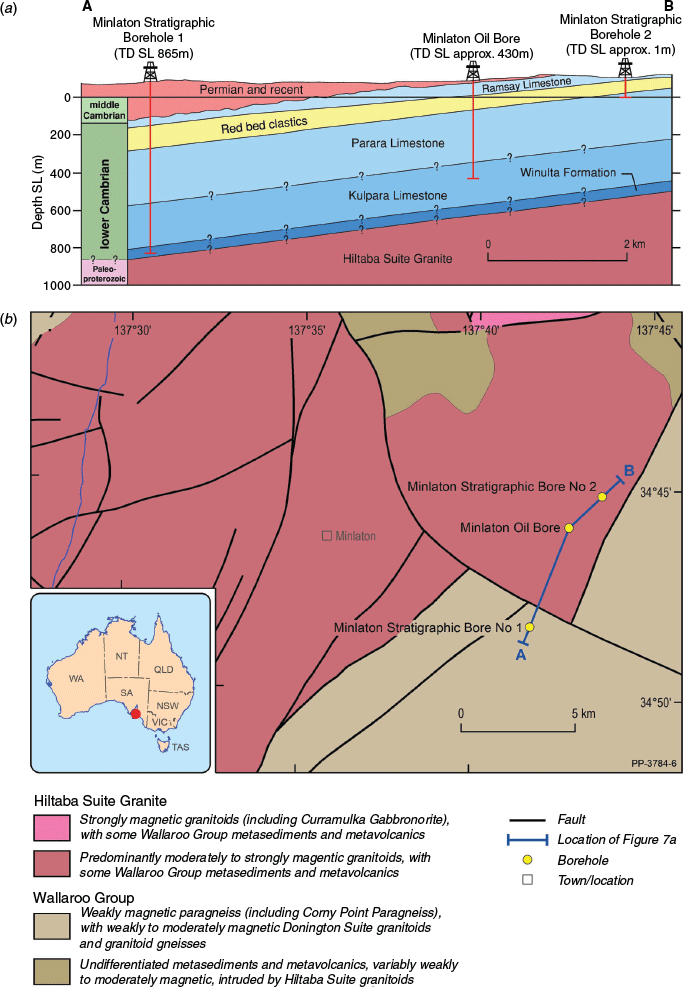
|
The Minlaton Oil Bore penetrated a Cambrian succession of the Stansbury Basin to a total depth of 1800 ft (548.64 m). The section is dominated by limestone and mudstone units with some red bed clastics. The nearest offset wells are Minlaton Stratigraphic 1 drilled in 1956 and Minlaton Stratigraphic 2 drilled in 1968 (Fig. 7b). Neither of these stratigraphic wells encountered gas shows and none reached crystalline basement. At Minlaton Oil Bore, the Cambrian succession is interpreted to unconformably overlie predominantly moderately to strongly magnetic granitoids of the Hiltaba Suite and some Walaroo Group metasediments. This interpretation is confirmed by the historical note (in a document held with the Ramsay Oil Bore 1 in the SARIG database) on two possible core samples from Minlaton Northwest 1. The first sample allegedly recovered from 1700 ft (518.1 m) consists of fine-grained red granite and the second allegedly recovered from 1900 ft (579.12 m) being of fine-grained amphibolite. This description suggests these two samples belong to the Tickera Granite of the Hiltaba Suite. The Tickera Granite is described as an intensely foliated orange granite, a white leucogranite, and a red granite at outcrop in the Point Riley area. Mineral grains within the intensely foliated orange granite comprise K-feldspar (70%), quartz (15%), biotite and amphibole (10%) and plagioclase (<5%) while hematite alterations are evident through the red/orange colour and hematite-filled veins that cut all minerals (Brotodewo 2016).
The Minlaton Oil Bore encountered moderately saline (NaCl-rich with 9.44 g/L total salts) groundwater at 160 ft (48.77 m). Water radiolysis associated with a high radioactive element content of the granite basement is the most likely source for the H2. However, a contributing H2 source possibly results from the interaction of the heavy brines with the biotite granite within the fractured basement rocks of the Tickera Granite. The available seismic data suggest that the basement faults in the vicinity of Minlaton Oil Bore extend into the Cambrian sediments (Fig. 8a). These faults could provide migration pathways for downward movement of heavy brines from the saline swamps as confirmed by the fact that the saline aquifer was penetrated by the the Minlaton Oil Bore. There are many saline pink lakes in the area, some of them, like Ramsay Park, are in the direct proximity of the Minlaton Oil Bore (Fig. 8b). The pink colouration can be associated with microbial hydrogenotrophic methanogenesis (Formolo 2010). Similar saline pink lakes are found in the surrounds of Pingrup, WA (https://www.albanygateway.com.au/towns/pingrup/), which are associated with clusters of circular depressions identified using satellite imagery (Larin et al. 2015; Rezaee 2020) and/or bleached vegetation termed fairy circles (Myagkiy et al. 2020; Moretti et al. 2021a, 2021b). Within the Yorke Peninsula including around the Minlaton Oil Bore, Moretti et al. (2021a) mapped 365 structures as fairy circles, likely indicating the pervasive nature of surface H2 seepage. A study of the Soultz-sous-Forêts geothermal site in France demonstrates that heavy brines circulating through biotite granite may lead to the generation of abiogenic H2 (Murray et al. 2020). Their simulations show that generation of natural H2 is possible in an open system by hydrothermal alteration of biotite as a source of Fe2+, which oxidises to Fe3+ leading to the precipitation of Fe3+ minerals and reduction of H+. Hence, this region in South Australia warrants further evaluation for its H2 resource potential.
Case study 3: Eastern Goldfields, Yilgarn Craton, WA
The Eastern Goldfields Superterrane is Australia’s premier gold mining region (Cassidy et al. 2006; Huston et al. 2012). Past gas discharges of CH4 and CO2 were recorded in the early 20th century (Simpson 1912), with CO2 flowing for many years, highlighting the potential for gas production at shallow depths. For example, the world’s only H2-producing field, represented by the Bougou 1 pioneer well (in Mali, western Africa), flowed H2 from 112 m (Prinzhofer et al. 2018). Hydrogen is also commonly found in ore deposits globally, including gold deposits (Zgonnik 2020). However, it was not until recently that H2-rich (generally with subordinate CH4) natural gas was found in Australian exploration drilling (to a maximum depth of 255 m) associated with the Frog’s Leg Gold Camp, about 20 km west of Kalgoorlie. Based on molecular and isotopic compositions of the gas components, H2 has an abiogenic source from a combination of serpentinisation of mafic–ultramafic rocks at minimum depths between 1.4 and 2.7 km (42.2–57°C) and from water radiolysis mediated by the radioactive decay of U-, Th- and K-bearing minerals in mainly basic rocks (Fig. 9; Boreham et al. 2021). The relative shallow depth and low temperature (where H2 is at its lowest solubility in aqueous solution; Lopez-Lazaro et al. 2019) of H2 generation suggests that free gas as microbubbles is likely available for advective migration (Boreham et al. 2021). In the region, gas generation has likely been continuous from ~2.7 billion years ago to present. Therefore, the potential for a larger volume of a deeper H2 resource exists, buoyed further by the presence of surface seepage of CH4 over gold deposits elsewhere in the Eastern Goldfields (Polito et al. 2002). Significant volumes of H2 may also be related to an extensive surface expression of potential H2 seepage across the Yilgarn region (Larin et al. 2015; Rezaee 2020; Moretti et al. 2021a).
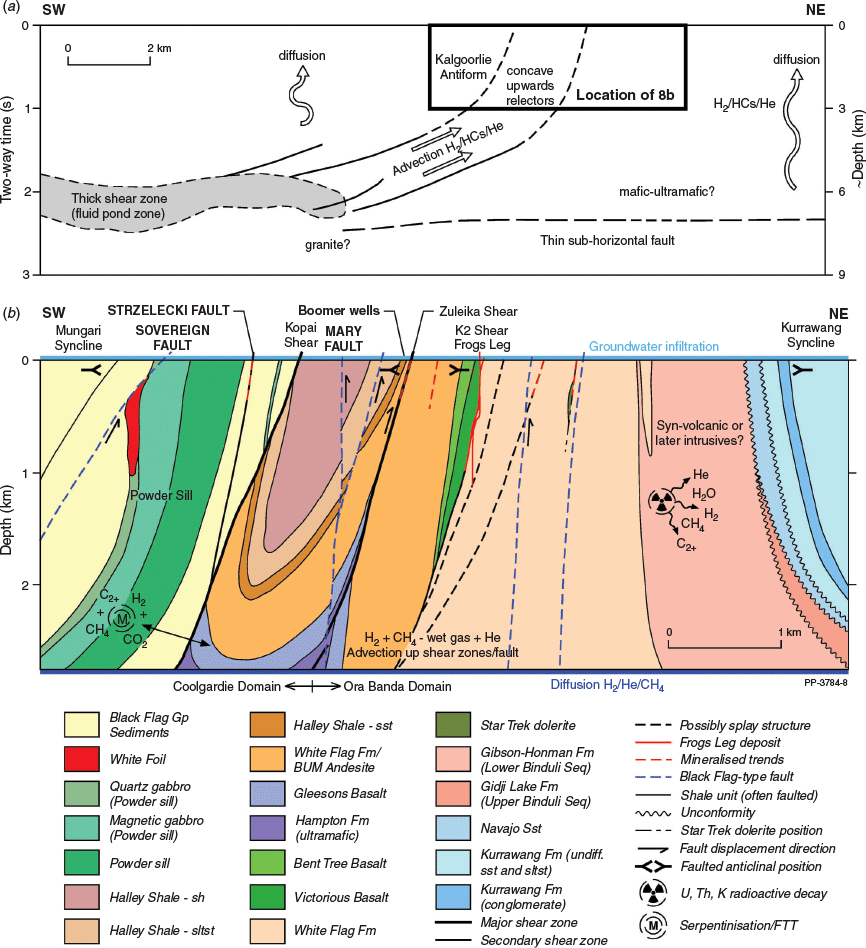
|
H2 inferred resource potential of onshore Australia
Herein, splitting of water due to interaction with radiation (radiolysis) and serpentinisation (hydration) are considered to be the only reactions leading to the production of H2 through time for onshore Australia. The relative contribution of these two H2 production pathways has been previously evaluated globally using the concentrations and decay rate of U, Th and K radioactive elements (Lin et al. 2005a, 2005b) with a small proportion (around 1%; Hofmann 1992; Boreham et al. 2021) of the released energy available for splitting of water to produce H2 plus H2 produced by serpentinisation (Sherwood Lollar et al. 2014). Calculations of hydration H2 production rates are either indirect, using the difference between measured and calculated H2/radiogenic noble gas (4He and 40Ar) ratios (Warr et al. 2019; Boreham et al. 2021) or direct, from the FeO content (i.e. 10 weight%) of the source rocks with 100% hydration or progressively decreasing percentage hydration with depth (Sherwood Lollar et al. 2014).
In the radiolysis H2 model, Sherwood Lollar et al. (2014) applied the average radioelement content of the upper and middle crust together and the depth-related porosity change to calculate the ratio of H2 (from ppm U, ppm Th, % K and porosity) and 4He (from ppm U and ppm Th) with H2/He of 117 and 15 for average upper and middle continental crust, respectively; the latter was excluded from their further calculations. They derived a crust fracture porosity related radiolytic H2 production rate of 1.6 × 1010 moles H2 year−1 (358 MMm3 H2 year−1 at STP) for global Precambrian continental rocks. In their direct ferrous iron hydration component, Sherwood Lollar et al. (2014) have bundled Australia within the global surface area of the Precambrian continental lithosphere of 1.06 × 108 km2 (86% Proterozoic and 14% Archean) where mafic and ultramafic rocks account for 36% (⅓ Proterozoic and ⅔ Archean) of the total surface area. Using an average FeO content of 10% for the mafic and ultramafic rocks, this resulted in a maximum annual hydration H2 production rate of 2.25 and 3.83 (using maximum values in Extended Data Tables 1 and 2 in Sherwood Lollar et al. 2014) times higher than H2 from water radiolysis at 1 and 5 km, respectively. From the data of Sherwood Lollar et al. (2014), the H2 inferred resource potential for the Australian craton is presented here by applying the following input parameters: Precambrian Australia has a surface area of ~5 060 000 km2 (~82% of onshore Australia) (Raymond et al. 2018) of which ~20% is Archean, and up to 15% is mafic and/or ultramafic with average 10 weight% FeO. This surface area corresponds to ~5% of global surface area provided by Sherwood Lollar et al. (2014) giving an onshore Australian Precambrian H2 (radiolysis + hydration) H2 production rate of between ~58 and ~254 MMm3 H2 year−1 to depths of 1 and 5 km, respectively. These numbers would be a maximum as the percentage of mafic and ultramafic rocks is considered to be lower in Australia than the 36% used by Sherwood Lollar et al. (2014).
In our alternative method, H2 yield was determined by calculating zonal statistics for radiometric U, K and Th radiometric concentrations and rock density data with the 1:1 000 000 scale surface geology map of Australia (Wilford and Kroll 2019; Supplementary Table S1). Our radiolytic H2 generation model adopts the approach of Lin et al. (2005b) as applied in Tarnas et al. (2018, 2020). Individual data are assigned to each 100 m × 100 m grid cell extending across onshore Australia. The porosity at the surface is assigned a constant 1600 kg m−3 with an exponential decrease in porosity with depth (Sherwood Lollar et al. 2014; Tarnas et al. 2018, 2020). A porosity of 1.45 volume% is used here representing the porosity at 0.5 km. The calculated radiolysis H2 production rate (molecules H2 kg−1 year−1; Table S1) is shown in Fig. 10. The summed total radiolysis H2 production rate is 499.2 Mm3 year−1, assuming a constant rock type over a depth range from surface to a depth of 1 km. The top four areas in order of decreasing radiolysis H2 production rates are the Mount Isa region under the Georgina Basin, the Georgetown region under the Carpentaria Basin, the King Leopold and Halls Creek Orogens and the Pine Creek Orogen.
Our calculated radiolytic H2 production value for onshore Australia is considerably lower than the estimated maximum radiolytic H2 production rate of ~25.6 MMm3 year−1 for Australian Precambrian continental crust where radiolytic H2 contribution is 44% (using minimum values in Table 2 in Sherwood Lollar et al. 2014) to the total H2 production rate (i.e. total = ~58 MMm3 year−1 derived above) (Sherwood Lollar et al. 2014). The wide difference (here ~51 fold) in calculated radiolysis H2 production rate using different methods was noted previously. Sherwood Lollar et al. (2014) found their estimate of global H2 production rate was 52 times higher than that of Lin et al. (2005b). The main reason given by Sherwood Lollar et al. (2014) was the absence of appropriate scaling methods for extrapolation from well-understood local scales to relatively unconstrained continental/global scales. Such limitations still exist today.
The ratio of summed total molecules radiolytic H2 kg−1 year−1/summed total atoms 4He kg−1 year−1 is 77 ± 13 (Table S1). Therefore, the calculate radiolytic H2 production rate (0.5 MMm3 year−1) is considered a minimum while it is only ~50% higher again using the crustal average H2/4He of 117 (Sherwood Lollar et al. 2014). An integral component of the calculation of the H2 production rate is the number of H2 molecules generated per 100 eV absorbed (G-H2, Tarnas et al. 2018, 2020). All calculations are based on G-H2 of pure water but saline water and absorbed H2O layers on minerals would have significantly higher G-H2 (Hofmann 1992; Wang et al. 2019). We have not assigned FeO contents to the same level of completeness as with the radioelements for onshore Australia. Thus, a hydration H2 production rate was not calculated by the direct approach. Instead, we assume the hydration H2 production rate is a maximum 225% of the radiolysis H2 production rate to a depth of 1 km (Sherwood Lollar et al. 2014), resulting in an H2 inferred total production rate of ~1.6 MMm3 year−1. Hence, the range in the calculated minimum H2 production rate for onshore Australia compares unfavourably elsewhere with measured, localised surface H2 seepage rates up to ~7 Mm3 day−1 (~2.5 MMm3 year−1) over a small 0.4 km2 structure (Moretti and Webber 2021) where serpentinisation and other (not including water radiolysis) H2 sources most likely predominate. The preceding highly variable estimates of H2 production rates highlight major limitations that current models have in numerical estimations of H2 production rates at the regional to global scales.
Here, the H2 assessment could be improved by using measured radioelement contents, by machine learning geochemical grid (e.g. Wilford et al. 2020) and levelled geochemistry (Main and Champion 2020). This would better reflect surface geochemistry for U, Th, K and Fe (potentially Fe2+ to Fe3+ ratio). Further, an estimated Australia-wide coverage of the relative proportions of ferrous (magnetite) and ferric (hematite) iron contents could be made by integrating regional gravity and magnetic datasets (e.g. Fig. 6a). In this way, the extent of the hydration reaction using the calculated weight% of magnetite based on total iron weight% can be assigned as an alternative to the FeO weight% direct method. The above total H2 inferred production rates do not account for H2 potentially generated within fluid inclusions (Sherwood Lollar et al. 2014) or other mechanisms (Table 1).
Towards an H2 exploration guideline
The extreme mobility of H2 facilitates its migration from depth to possible shallower reservoirs by both diffusive and advective mechanisms, primarily driven by buoyancy and concentration gradients (Etiope 2015) but still requires the H2 generation rate to exceed the H2 rate of uptake in sinks, for example, layered silicates, salt formations and organic-rich deposits. Surface H2 seepage observed directly (measurable) or indirectly (e.g. circular-oval depressions and fairy circles; Prinzhofer et al. 2019, and references therein; Myagkiy et al. 2020; Rezaee 2020; Moretti et al. 2021a, 2021b) is an expression of either an absence of an effective seal or a leaking seal. A key to H2 in elevated surface concentrations appears to be the presence of an aquifer near a fault zone (Dugamin et al. 2019). However, the most important parameter to be gleaned from H2 seepage is its magnitude, which is a good guide to the size of the underlying H2 resource and to its sustainability (Cathles and Prinzhofer 2020). However, spot surface sampling is discouraged. Instead a program of continuous monitoring for at least 24 h at multiple, closely spaced monitoring sites is highly recommended (Moretti et al. 2021b). Sustainable, renewed hydrogen accumulations are likely emphasised with the presence of carbon monoxide (Prinzhofer et al. 2018). The large variety of H2 sources with their accompanying rocks types and fluids (see Geological occurrences, sources and sinks of H2; Table 1) will ensure that future explorationists for natural H2 will need to rely on a more extensive guidebook.
Natural H2-rich gas occurs predominately outside petroleum-focused exploration in sedimentary basins. However, recent exploration drilling specifically for natural H2 has focused on areas with known occurrences of H2-rich natural gas that were discovered decades before as a consequence of conventional drilling for oil and gas (Prinzhofer 2018; Zgonnik 2020). A recent comprehensive review outlining where H2-rich natural gases are found provides obvious (ibid) pointers where to look for future potential natural H2 resources – these areas include:
onshore igneous rocks provide a wide range of environments with H2-rich gas occurring as free gas, dissolved gas and trapped in fluid inclusions within ophiolites, rift zones, faults and atmospheric degassing in volcanic gases, geysers, hot springs and surface gas seeps;
kimberlite pipes are rarely associated with H2-rich gas but where found host high flow rates (0.1 MMm3 day−1) of natural H2;
ore bodies are a major site of H2-rich gas in both igneous and sedimentary rocks;
coal seams (absorbed) and/or carbonates (adsorbed) offer high H2 storage capacity;
within gas–water fluid inclusions where the older the rock the higher the H2 abundance, because time is a primary control on the extent of water radiolysis involving 235, 238U,232Th and 40K radioactive decay;
evaporitic sulfates can store high abundance of H2 (up to 20–30% by volume) while halite with high K content (e.g. K-potash deposits) also provides a radiogenic-hydrolytic source of H2 through a calcium (Ca) metal intermediate together with salt being a good seal rock; and
oil and gas fields typically do not contain high H2, nevertheless for those with elevated H2 contents H2 production may be viable via association with liquefied natural gas (LNG; see below).
The reactive nature of H2 affects the structure and chemical composition of the rock it transverses, for example, the mechanical strength of carbonates decreases (Levshounova 1991), potentially accelerating the development of fractures under stress regimes with the creation of additional migration pathways. Downhole H2 contents commonly increase with depth (Parnell and Blamey 2017). Zgonnik (2020) suggests that H2 is too diffusive and too reactive to accumulate in significant concentration in geological traps. However, the goal to the development of a robust exploration guideline is to provide a range of potential targets each with their specific characteristics for H2 generation, migration and retention (Fig. 11).
Truche and Bazarkina (2019) and Donze et al. (2020) have outlined a preliminary H2 exploration guide, based heavily on ore-targeting approaches and globally high H2 occurrences, condensed into three key factors associated with onshore occurrences with elevated H2 contents; all of which (together with the preceding dot points above) are directly applicable to H2 exploration in Australia, as outlined below:
the presence of Fe-rich rocks, particularly Archean basement rocks as potential sources for both radiolytic and hydrolytic H2 generation (e.g. Case studies 1–3);
deep-rooted basement faults that can provide the migration pathways and the focus for diffuse H2 sources (e.g. Case studies 1–3; Fig. 11); and
reservoir potential at depth at the interface between basement and sedimentary rocks (Fig. 11). For example, natural gas from the Mt Kitty 1 well (Amadeus Basin) has 11 mol% H2 within fractured igneous basement directly overlain by sedimentary rocks (McInnes et al. 2017).
Note: H2 generation with no genetic link to neither ultramafic rocks nor faults requires broader guidelines (Truche and Bazarkina 2019).
Additionally, and from the Australian perspective, Australia’s enormous endowment in mineral and natural gas reserves/resources provides an advantage and solid foundation for multiple potential H2 systems in the geological settings outlined herein. The local volumetric bias towards Precambrian cratons allows optimum resident time and, together with high heat producing granites (Huston et al. 2012), should maximise radiolytic H2 generation. Opportunities lay under evaporite seals for H2 accumulations (Figs 4 and 11). Based on limited well penetration from petroleum exploration, for example, thick (>100 m) halite sequences are concentrated in central and western Australia (Fig. 4). Although evaporite seals (halite) are a priority for He entrapment, especially in the Amadeus and Officer basins (Haines and Allen 2020), dual natural H2 and He prospects should also be considered, not only in these two basins but also in the surrounding Precambrian basins (Fig. 4). Furthermore, evaporitic rocks beside halite, e.g. potash and gypsum, may also provide H2 storage and sealing opportunities in other sedimentary basins (e.g. Georgina Basin). Future discoveries of thick evaporites in under-represented eastern Australia should raise opportunities for natural H2 exploitation closer to major population centres.
Although natural H2 content in Australian natural gases is generally low, H2 enrichment will occur during LNG processing. H2 contents in Australian natural gases can exceed He concentrations. There is an estimated He resource of around 100 Bcf based on analysed He contents in offshore and onshore wells (Boreham et al. 2018). Given that a large proportion of Australian natural gas to market is in LNG, potential opportunities may exist for LNG-linked H2 recovery, as there are presently for He. For example, in Australia’s only He processing plant (Darwin Helium, Darwin, Northern Territory) the He feedstock gas (i.e. tail gas from the Darwin LNG plant) has around 3 mol% He, i.e. concentrated by around 30 times to that of the LNG plant’s feed gas (from the offshore Bayu-Undan offshore gas field), whereas there the H2 content was considerably lower (Boreham et al. 2018). Finally, the development of predictive H2 exploration guidelines will greatly assist natural H2, in particular from an abiogenic source, becoming an increasingly attractive exploration target.
Conclusions
Most Australian natural gases contain natural H2, although H2 concentrations in the majority of these gases are at low to trace levels (i.e. less than 0.01 mol%). Encouragingly, there are a few with very high H2 contents (i.e. >10 mol%) that are mainly associated with Precambrian H2 sources. The stable hydrogen isotopic composition of H2 in the small number of Australian gases analysed in this study is highly depleted in 2H, supporting a predominant abiogenic source. The wide range in natural H2 sources necessitates diverse exploration strategies that must take into account migration pathways and trapping mechanisms. An obvious starting point for H2 exploration is with the characterisation of H2 surface seepage proxies using remote sensing techniques coupled with physical sample collection. Although H2 surface flow rates are relatively low, their intensity points to similarly scaled undercover H2 resources. Such an approach mimics the state of play at the beginning of petroleum exploration in the late 19th Century. Needless to say, the first oil explorers could only imagine the vast petroleum resources of today.
Precambrian basement rocks are the obvious exploration choice given the large number of known H2 discoveries globally, their composition and the excessive time available for serpentinisation and radiolysis processes; two of the main H2 producing reactions in the geosphere and amenable to modelling. Based on these two reactions, onshore Australia is estimated to support a maximum H2 inferred resource potential of ~1.6 to ~58 MMm3 year−1 down to a depth of 1 km.
With the aid of geochemical, geophysical and petrophysical techniques, the identification of substantial sedimentary thickness above basement with associated magmatic intrusions, would be a paramount requirement to increase the possibility of large occurrences of natural H2 in continuous reservoirs and tight seals. Further, fault-accessible reservoirs can readily accept deep advective H2, while diffuse H2 may not necessarily enhance H2 concentration within petroleum reservoirs due to its high reactivity.
Hydrogen is carbon-free, but unlike fossil fuels it is continuously being generated from the same source over a wider range of depths and temperature providing ‘timeless hydrogen’. Given the enormous, cumulative amount of H2 that has been generated since the earth was formed, the likelihood of potentially large H2 reservoirs is considered high, awaiting discovery using proven exploration guidelines.
Supplementary material
Table S1. Data used to estimate H2 resource potential for onshore Australian to a depth of 1 km are available on the journal’s website as Supplementary material to this paper.
Conflicts of interest
The authors declare no conflicts of interest.
Declaration of funding
No funding from external organisations was received for this research.
Acknowledgements
Junhong Chen and Neel Jinadasa are thanked for assistance with laboratory analyses along with Tamara Buckler for database management and data retrievals. Tom Bernecker and Emmanuelle Grosjean are thanked for their reviews of a presubmission version of the manuscript. Chris Evenden provided assistance in drafting the figures. CJB wishes to specifically acknowledge Emma Proudlock, CSIRO Publishing, for her preparedness to accommodate new datasets in the manuscript’s revisions. All authors (beside K.C.) publish with the permission of the CEO, Geoscience Australia. K.C. publishes with the permission of the Executive Director, Geological Survey of New South Wales.
References
Abrajano, T. A., Surchio, N. C., Kennedy, B. M., Lyon, G. L., Muehlenbachs, K., and Bohlke, J. K. (1990). Geochemistry of reduced gas related to serpentinization of the Zambales ophiolite, Philippines. Applied Geochemistry 5, 625–630.| Geochemistry of reduced gas related to serpentinization of the Zambales ophiolite, Philippines.Crossref | GoogleScholarGoogle Scholar |
Adolf, J., Blazer, C. H., Jurgen, L., Schabla, U., Fischedick, M., Arnold, K., Pastowski, A., and Schüwer, D. (2017). Shell hydrogen study energy of the future? Sustainable mobility through fuel cells and H2. Available at
Adushkin, V. V., Kudryavtsev, V. P., and Khazins, V. M. (2006). Hydrogen degassing of the earth and ozone anomalies. Doklady Earth Sciences 406, 79–81.
| Hydrogen degassing of the earth and ozone anomalies.Crossref | GoogleScholarGoogle Scholar |
Amid, A., Mignarda, D., and Wilkinson, M. (2016). Seasonal storage of hydrogen in a depleted natural gas reservoir. International Journal of Hydrogen Energy 41, 5549–5558.
| Seasonal storage of hydrogen in a depleted natural gas reservoir.Crossref | GoogleScholarGoogle Scholar |
Andreani, M., Mével, C., Boullier, A.-M., and Escartin, J. (2007). Dynamic control on serpentine crystallization in veins: constraints on hydration processes in oceanic peridotites. Geochemistry Geophysics Geosystems 8, Q02012.
| Dynamic control on serpentine crystallization in veins: constraints on hydration processes in oceanic peridotites.Crossref | GoogleScholarGoogle Scholar |
Apps, J. A., and van de Kamp, P. C. (1993). Energy gases of abiogenic origin in the Earth’s crust. In ‘Future Energy Gases.’ (United States Geological Survey Professional Paper 1570, pp. 81–130.)
AusH2 (2020). COAG Energy Council - Australia’s Hydrogen Opportunities Tool. Available at https://portal.ga.gov.au/persona/hydrogen [Verified 4 January 2021].
Australian Occidental P/L (1982). Mercury 1 well completion report. Available at https://minerals.sarig.sa.gov.au/SearchResults.aspx [Verified 4 January 2021].
Batenburg, A. M., Walter, S., Pieterse, G., Levin, I., Schmidt, M., Jordon, A., Hammer, S., Yver, C., and Röckmann, T. (2011). Temporal and spatial variability of the stable isotopic composition of atmospheric molecular hydrogen: observations at six EUROHYDROS stations. Atmospheric Chemistry and Physics 11, 6985–6999.
| Temporal and spatial variability of the stable isotopic composition of atmospheric molecular hydrogen: observations at six EUROHYDROS stations.Crossref | GoogleScholarGoogle Scholar |
Bjornstad, B. N., McKinley, J. P., Stevens, T. O., Rawson, S. A., Fredrickson, J. K., and Long, P. E. (1994). Generation of hydrogen gas as a result of drilling within the saturated zone. Groundwater Monitoring and Remediation 14, 140–147.
| Generation of hydrogen gas as a result of drilling within the saturated zone.Crossref | GoogleScholarGoogle Scholar |
Blesa, M. A., and Matijević, E. (1989). Phase transformations of iron oxides, oxohydroxides, and hydrous oxides in aqueous media. Advances in Colloid and Interface Science 29, 173–221.
| Phase transformations of iron oxides, oxohydroxides, and hydrous oxides in aqueous media.Crossref | GoogleScholarGoogle Scholar |
Boone, D. R., Johnson, R. L., and Liu, Y. (1989). Diffusion of the interspecies electron carriers H2 and formate in methanogenic ecosystems and its implications in the measurement of Km for H2 or formate uptake. Applied and Environmental Microbiology 55, 1735–1741.
| Diffusion of the interspecies electron carriers H2 and formate in methanogenic ecosystems and its implications in the measurement of Km for H2 or formate uptake.Crossref | GoogleScholarGoogle Scholar | 16347966PubMed |
Boreham, C. J., and Davies, J. B. (2020). Carbon and hydrogen isotopes of the wet gases produced by gamma-ray-induced polymerisation of methane: insights into radiogenic mechanism and natural gas formation. Radiation Physics and Chemistry 168, 108546.
| Carbon and hydrogen isotopes of the wet gases produced by gamma-ray-induced polymerisation of methane: insights into radiogenic mechanism and natural gas formation.Crossref | GoogleScholarGoogle Scholar |
Boreham, C. J., Hope, J. M., and Hartung-Kagi, B. (2001). Understanding source, distribution and preservation of Australian natural gas: a geochemical perspective. The APPEA Journal 41, 523–547.
| Understanding source, distribution and preservation of Australian natural gas: a geochemical perspective.Crossref | GoogleScholarGoogle Scholar |
Boreham, C. J., Edwards, D. S., Poreda, R. J., Darrah, T. H., Zhu, R., Grosjean, E., Main, P., Waltenberg, K., and Henson, P. A. (2018). Helium in the Australian liquefied natural gas economy. The APPEA Journal 58, 209–237.
| Helium in the Australian liquefied natural gas economy.Crossref | GoogleScholarGoogle Scholar |
Boreham, C. J., Sohn, J. H., Cox, N., Williams, J., Hong, Z., and Kendrick, M. (2021). Hydrogen and hydrocarbons associated with the Neoarchean Frog’s Leg Gold Camp, Yilgarn Craton, Western Australia. Chemical Geology , .
| Hydrogen and hydrocarbons associated with the Neoarchean Frog’s Leg Gold Camp, Yilgarn Craton, Western Australia.Crossref | GoogleScholarGoogle Scholar |
Bouquet, A., Glein, C. R., Wyrick, D., and Waite, J. H. (2017). Alternative energy: production of H2 by radiolysis of water in the rocky cores of icy bodies. The Astrophysical Journal Letters 840, L8.
| Alternative energy: production of H2 by radiolysis of water in the rocky cores of icy bodies.Crossref | GoogleScholarGoogle Scholar |
Boyd, A. W., Willis, C., and Miller, O. A. (1973). The radiolysis of water vapor at very high dose rates. I. hydrogen yields from H2O,H2O-HCl, and H2O-HBr mixtures. Canadian Journal of Chemistry 51, 4048–4055.
| The radiolysis of water vapor at very high dose rates. I. hydrogen yields from H2O,H2O-HCl, and H2O-HBr mixtures.Crossref | GoogleScholarGoogle Scholar |
BP (2019). BP statistical review of world energy 68th edition. Available at https://www.bp.com/content/dam/bp/business-sites/en/global/corporate/pdfs/energy-economics/statistical-review/bp-stats-review-2019-natural-gas.pdf [Verified 4 January 2021].
Bradshaw, B. E., Orr, M. L., Bailey, A. H. E., Palu, T. J., and Hall, L. S. (2018). Northern Lawn Hill platform depth structure and isochore mapping update. Record 2018/47. Geoscience Australia, Canberra. Available at
Briere, D., Jerzykiewicz, T., and Śliwiński, W. (2017). On generating a geological model for hydrogen gas in the southern Taoudeni Megabasin (Bourakebougou area, Mali). Available at https://www.academia.edu/25406456/On_generating_a_Geological_Model_for_Hydrogen_Gas_in_the_Southern_Taoudeni_Megabasin_Bourakebougou_area_Mali?email_work_card=view-paper [Verified 14 January 2021].
Brotodewo, A. (2016). Relationship between magmatism and deformation in south-eastern Proterozoic Australia. Honours degree thesis, Adelaide University. https://www.semanticscholar.org/paper/Relationships-between-magmatism-and-deformation-in-Brotodewo/3fe79863b858a7355f40e79b962c99f2a440f21c
Brovarone, A. V., Martinez, I., Elmaleh, A., Compagnon, R., Chaduteau, C., Ferraris, C., and Esteve, I. (2017). Massive production of abiotic methane during subduction evidenced in metamorphosed ophicarbonates from the Italian Alps. Nature Communications 8, 14134.
| Massive production of abiotic methane during subduction evidenced in metamorphosed ophicarbonates from the Italian Alps.Crossref | GoogleScholarGoogle Scholar |
Bruce, R. (2015). Paleozoic Basins of Western Australia - Conventional Plays Abound. AAPG/SEG International Conference and Exhibition, Melbourne, Australia, September 13–16, 2015. Available at http://www.searchanddiscovery.com/pdfz/documents/2015/10801bruce/ndx_bruce.pdf.html [Verified 4 January 2021].
Bruce, S., Temminghoff, M., Hayward, J., Schmidt, E., Munnings, C., Palfreyman, D., and Hartley, P. (2018). National Hydrogen Roadmap. CSIRO, Australia. Available at https://publications.csiro.au/rpr/pub?pid=csiro:EP184600 [Verified 4 January 2021].
Burrett, C., and Tanner, D. (1997). Great South Land Minerals Pty. Ltd. 1997 Annual Report. Mineral Resources Tasmania Report 97-4088. Available at https://www.mrt.tas.gov.au/webdoc2/app/default/drilling_detail?id=19071 [Verified 28 May 2021].
Caglayan, D. G., Weber, N., Heinrichs, H, Linssen, J., Robinius, M., Kukla, P. A., and Stolten, D. (2020). Technical potential of salt caverns for hydrogen storage in Europe. International Journal of Hydrogen Energy 45, 6793–6805.
| Technical potential of salt caverns for hydrogen storage in Europe.Crossref | GoogleScholarGoogle Scholar |
Cannat, M., Fontaine, F., and Escartin, J. (2010). Serpentinization and associated hydrogen and methane fluxes at slow spreading ridges. In ‘Diversity of Hydrothermal Systems on Slow Spreading Ocean Ridges.’ (Eds P. A. Rona, C. W. Devey, J. Dyment, and B. J. Murton). (Geophysical Monograph 188, 241–264.)
Carr, L. K., Korsch, R. J., Mory, A. J., Hocking, R. M., Marshall, S. K., Costelloe, R. D., Holzschuh, J., and Maher, J. L. (2012). Structural and stratigraphic architecture of western Australia’s frontier onshore sedimentary basins: the western Officer and southern Carnarvon basins, Western Australia. The APPEA Journal 52, 670.
| Structural and stratigraphic architecture of western Australia’s frontier onshore sedimentary basins: the western Officer and southern Carnarvon basins, Western Australia.Crossref | GoogleScholarGoogle Scholar |
Carr, L. K., Southby, C., Henson, P., Anderson, J. R., Costelloe, R., Jarrett, A. J. M., Carson, C. J., MacFarlane, S. K., Gorton, J., Hutton, L., Troup, A., Williams, B., Khider, K., Bailey, A. H. E., and Fomin, T. (2020). South Nicholson Basin seismic interpretation. ‘Exploring for the Future: Extended Abstracts.’ (Eds K. Czarnota, I. Roach, S. Abbott, M. Haynes, N. Kositcin, A. Ray, and E. Slatter) pp. 1–4. (Geoscience Australia, Canberra.) Available at http://pid.geoscience.gov.au/dataset/ga/132029 [Verified 4 January 2021].
Carson, C. J., Kositcin, N., Anderson, J. R., Cross, A., and Henson, P. A. (2020). New U–Pb geochronology for the South Nicholson region and implications for stratigraphic correlations. In ‘Exploring for the Future: Extended Abstracts.’ (Eds K. Czarnota, I. Roach, S. Abbott, M. Haynes, N. Kositcin, A. Ray, and E. Slatter) pp. 1–4. (Geoscience Australia, Canberra.) Available at
Cassidy, K. F., Champion, D. C., Krapež, B., Barley, M. E., Brown, S. J. A., Blewett, R. S., Groenewald, P. B., and Tyler, I. M. (2006). A revised geological framework for the Yilgarn Craton, Western Australia, Western Australia Geological Survey, Record 2006/8.
Cathles, L., and Prinzhofer, A. (2020). What pulsating H2 emissions suggest about the H2 resource in the Sao Francisco Basin of Brazil. Geosciences 10, 149.
| What pulsating H2 emissions suggest about the H2 resource in the Sao Francisco Basin of Brazil.Crossref | GoogleScholarGoogle Scholar |
Christensen, H., and Bjergbakke, E. (1982). Radiolysis of ground water from spent fuel: Swedish Nuclear Safety Project. Studsvik/NW–82/364.
COAG Energy Council Hydrogen Working Group (2019). Australia’s national hydrogen strategy. Available at https://www.industry.gov.au/sites/default/files/2019-11/australias-national-hydrogen-strategy.pdf [Verified 4 January 2021].
Coveney, R. M., Goebel, E. D., Dreschhoff, G. A. M., and Angino, E. E. (1987). Serpentinization and the origin of hydrogen gas in Texas. Bulletin of the American Association of Petroleum Geologists 71, 39–48.
| Serpentinization and the origin of hydrogen gas in Texas.Crossref | GoogleScholarGoogle Scholar |
Czarnota, K., Hoggard, M. J., Richards, F. D., Teh, M., Huston, D. L., Jaques, A. L., and Ghelichkhan, S. (2020). Minerals on the edge: sediment-hosted base metal endowment above steps in lithospheric thickness. In ‘Exploring for the Future: Extended Abstracts.’ (Eds K. Czarnota, I. Roach, S. Abbott, M. Haynes, N. Kositcin, A. Ray, and E. Slatter) pp. 1–4. (Geoscience Australia, Canberra.) Available at
Donze, F. V., Truche, L., Sheraki Namin, P., Lefeuvre, N., and Bazarkina, E. (2020). Migration of natural hydrogen from deep-seated sources in the São Francisco Basin, Brazil. Preprints 2020, 2020070571.
| Migration of natural hydrogen from deep-seated sources in the São Francisco Basin, Brazil.Crossref | GoogleScholarGoogle Scholar |
Drobner, E., Huber, H., Wächterschäuser, G., Rose, D., and Stetter, K. O. (1990). Pyrite formation linked with hydrogen evolution under anaerobic conditions. Nature 346, 742–744.
| Pyrite formation linked with hydrogen evolution under anaerobic conditions.Crossref | GoogleScholarGoogle Scholar |
Drummond, B. E, Hobbs, B. J., Hobbs, R. W, and Goleby, B.R. (2004). Crustal fluids in tectonic evolution and mineral systems: evidence from the Yilgarn Craton. In ‘Predictive Mineral Discovery Cooperative Research Centre - Extended Abstracts from the June 2004 Conference’ (Eds A. C. Barnicoat, and R. J. Korsch) pp. 33–38. Geoscience Australia, Record 2004/09.
Duan, J., Kyi, D., and Jiang, W. (2020). AusLAMP-EFTF – imaging the Northern Australian Lithosphere for Resource Potential. In ‘Exploring for the Future: Extended Abstracts.’ (Eds K. Czarnota, I. Roach, S. Abbott, M. Haynes, N. Kositcin, A. Ray, and E. Slatter) pp. 1–4. (Geoscience Australia, Canberra.) Available at
Dubessy, J., Poty, B., and Ramboz, C. (1989). Advances in C-O-H-N-S fluid geochemistry based on micro-Raman spectrometric analysis of fluid inclusions. European Journal of Mineralogy 1, 517–534.
| Advances in C-O-H-N-S fluid geochemistry based on micro-Raman spectrometric analysis of fluid inclusions.Crossref | GoogleScholarGoogle Scholar |
Dugamin, E., Truche, L., and Donzé, F. V. (2019). ‘Natural Hydrogen Exploration Guide’. (Ed. Geonum). ISRN GEONUM-NST--2019-01--ENG, pp. 1–16.
Dzaugis, M. E., Spivack, A. J., Dunlea, A. G., Murray, R. W., and D’Hondt, S. (2016). Radiolytic hydrogen production in the subseafloor basaltic aquifer. Frontiers in Microbiology 7, 76.
| Radiolytic hydrogen production in the subseafloor basaltic aquifer.Crossref | GoogleScholarGoogle Scholar | 26870029PubMed |
Ehhalt, D. H., and Rohrer, F. (2009). The tropospheric cycle of H2: a critical review. Tellus B: Chemical and Physical Meteorology 61, 500–535.
| The tropospheric cycle of H2: a critical review.Crossref | GoogleScholarGoogle Scholar |
Ehhalt, D. H., and Rohrer, F. (2011). The dependence of soil H2 uptake on temperature and moisture: a reanalysis of laboratory data. Tellus B: Chemical and Physical Meterology 63, 1040–1051.
| The dependence of soil H2 uptake on temperature and moisture: a reanalysis of laboratory data.Crossref | GoogleScholarGoogle Scholar |
Erzinger, J., Wiersberg, T., and Zimmer, M. (2006). Real-time mud gas logging and sampling during drilling. Geofluids 6, 225–233.
| Real-time mud gas logging and sampling during drilling.Crossref | GoogleScholarGoogle Scholar |
Etiope, G. (2015). ‘Natural Gas Seepage – the Earth’s hydrocarbon degassing.’ (Springer International Publishing: Switzerland AG.) Available at
Etiope, G., and Ionescu, A. (2015). Low-temperature catalytic CO2 hydrogenation with geological quantities of ruthenium: a possible abiotic CH4 source in chromitite-rich serpentinized rocks. Geofluids 15, 438–452.
| Low-temperature catalytic CO2 hydrogenation with geological quantities of ruthenium: a possible abiotic CH4 source in chromitite-rich serpentinized rocks.Crossref | GoogleScholarGoogle Scholar |
Etiope, G., and Whiticar, M. J. (2019). Abiotic methane in continental ultramafic rock systems: towards a genetic model. Applied Geochemistry 102, 139–152.
| Abiotic methane in continental ultramafic rock systems: towards a genetic model.Crossref | GoogleScholarGoogle Scholar |
Evans, B. W., Hattori, K., and Baronnet, A. (2013). Serpentinite: what, why, where? Elements 9, 99–106.
| Serpentinite: what, why, where?Crossref | GoogleScholarGoogle Scholar |
Federal Ministry for Economic Affairs and Energy (FMEAE), Germany. (2020). The National Hydrogen Strategy, Federal Ministry for Economic Affairs and Energy: Berlin. Available at https://www.bmwi.de/Redaktion/EN/Publikationen/Energie/the-national-hydrogen-strategy.html [Verified 4 January 2021].
Feldbusch, E., Wiersberg, T., Zimmer, M., and Regenspurg, S. (2018). Origin of gases from the geothermal reservoir Groß Schönebeck (North German Basin). Geothermics 71, 357–368.
| Origin of gases from the geothermal reservoir Groß Schönebeck (North German Basin).Crossref | GoogleScholarGoogle Scholar |
Felton, E. A., Miyazaki, S., Dowling, L., Pain, L., Vuckovic, V., and le Poidevin, S. R. (1993). Carnarvon Basin, WA. Bureau of Resource Sciences, Australian Petroleum Accumulation Report 8, 1993. Available at http://www.ga.gov.au/webtemp/image_cache/GA9154.pdf [Verified 4 January 2021].
Flesch, S., Pudlo, D., Albrecht, D., Jacob, A., and Enzmann, F. (2018). Hydrogen underground storage – petrographic and petrophysical variations in reservoir sandstones from laboratory experiments under simulated reservoir conditions. International Journal of Hydrogen Energy 43, 20822–20835.
| Hydrogen underground storage – petrographic and petrophysical variations in reservoir sandstones from laboratory experiments under simulated reservoir conditions.Crossref | GoogleScholarGoogle Scholar |
Flude, S., Warr, O., Magalhães, N., Bordmann, V., Fleury, J. M., Reis, H. L. S., Trindade, R. I., Hillegonds, D., Sherwood Lollar, B., and Ballentine, C. J. (2019). Deep crustal source for hydrogen and helium gases in the São Francisco Basin, Minas Gerais, Brazil. Available at https://ui.adsabs.harvard.edu/abs/2019AGUFMEP51D2111F/abstract [Verified 28 November 2020].
Fomin, T., Holzschuh, J., Costelloe, R. D., and Henson, P. (2020). Deep northern Australian 2D seismic reflections surveys. In ‘Exploring for the Future: Extended Abstracts.’ (Eds K. Czarnota, I. Roach, S. Abbott, M. Haynes, N. Kositcin, A. Ray, and E. Slatter) pp. 1–4. (Geoscience Australia, Canberra.) Available at https://ecat.ga.gov.au/geonetwork/srv/eng/catalog.search#/metadata/134962 [Verified 12 January 2021].
Formolo, M. (2010). The microbial production of methane and other volatile hydrocarbons. In ‘Handbook of Hydrocarbon and Lipid Microbiology’ (Ed K. N. Timmis) pp. 113–126. (Springer-Verlag Berlin Heidelberg.)
Freund, F., Dickinson, J. T., and Cash, M. (2002). Hydrogen in rocks: an energy source for deep microbial communities. Astrobiology 2, 83–92.
| Hydrogen in rocks: an energy source for deep microbial communities.Crossref | GoogleScholarGoogle Scholar | 12449857PubMed |
Gill, G. (2017). SA Roundtable for oil & gas underground gas storage 101. November 30, 2017. Available at http://www.energymining.sa.gov.au/__data/assets/pdf_file/0009/301698/Presentation_4_-_Innovative_Energy_Consulting_-_Glen_Gill.pdf [Verified 15 January 2021].
Gill, G., and Cowan, G. (2008). Adavale Basin, Queensland Underground Salt Cavern Potential. Available at https://docplayer.net/41868004-Adavale-basin-queensland-underground-salt-cavern-potential.html [Verified January 2021].
Glein, C. R., and Zolotov, M. Y. (2020). Hydrogen, hydrocarbons, and habitability across the solar system. Elements 16, 47–52.
| Hydrogen, hydrocarbons, and habitability across the solar system.Crossref | GoogleScholarGoogle Scholar |
Glindermann, D., Edwards, M., and Morgenstern, P. (2005). Phosphine from rocks: mechanically driven phosphate reduction? Environmental Science and Technology 39, 7671–7675.
| Phosphine from rocks: mechanically driven phosphate reduction?Crossref | GoogleScholarGoogle Scholar |
Goebel, E. D., Coveney, R. M., Angino, E. E., Zeller, E. J., and Dreschhoff, G. A. M. (1984). Geology, composition, isotopes of naturally occurring H2/N2 rich gas from wells near Junction City, Kansas. Oil and Gas Journal 82, 215–222.
Goodwin, J. A., and Skirrow, R. G. (2019). Producing magnetite and hematite alteration proxies using 3D gravity and magnetic inversion - method and results for the Tennant-Isa Project, northern Australia. Record 2019/03. Geoscience Australia, Canberra. Available at
Gregory, S. P., Barnett, M. J., Field, L. P., and Milodowski, A. E. (2019). Subsurface microbial hydrogen cycling: natural occurrence and implications for industry. Microorganisms 7, 53.
| Subsurface microbial hydrogen cycling: natural occurrence and implications for industry.Crossref | GoogleScholarGoogle Scholar |
Guélard, J., Beaumont, V., Rouchon, V., Guyot, F., Pillot, D., Jézéquel, D., Ader, M., Newell, K. D., and Deville, E. (2017). Natural H2 in Kansas: deep or shallow origin? Geochemistry Geophysics Geosystems 18, 1841–1865.
| Natural H2 in Kansas: deep or shallow origin?Crossref | GoogleScholarGoogle Scholar |
Haines, P. W., and Allen, H. J. (2020). World’s oldest regional salt seal in the Amadeus and Officer basins: implications for subsalt helium and hydrocarbons. GSWA 2020 Extended Abstracts. Advancing the prospectivity of Western Australia. Available at https://dmpbookshop.eruditetechnologies.com.au/product/worlds-oldest-regional-salt-seal-in-the-amadeus-and-officer-basins-implications-for-subsalt-helium-and-hydrocarbons.do [Verified 4 January 2021].
Halas, P., Dupuy, A., Franceschi, M., Boardmann, V., and Fleury, J-M. (2021). Hydrogen gas in circular depressions in South Gironde, France: Flux, stock, or artefact? Applied Geochemistry 127, 104928.
| Hydrogen gas in circular depressions in South Gironde, France: Flux, stock, or artefact?Crossref | GoogleScholarGoogle Scholar |
Hallenbeck, P. C., and Benemann, J. R. (2002). Biological hydrogen production; fundamentals and limiting processes. International Journal of Hydrogen Energy 27, 1185–1193.
| Biological hydrogen production; fundamentals and limiting processes.Crossref | GoogleScholarGoogle Scholar |
Hao, Y., Pang, Z., Tian, J., Wang, Y., Li, Z., and Li, L. (2020). Origin and evolution of hydrogen-rich gas discharges from a hot spring in the eastern coastal area of China. Chemical Geology 538, 119477.
| Origin and evolution of hydrogen-rich gas discharges from a hot spring in the eastern coastal area of China.Crossref | GoogleScholarGoogle Scholar |
Hirose, T., Kawagucci, S., and Suzuki, K. (2011). Mechanoradical H2 generation during simulated faulting: implications for an earthquake-driven subsurface biosphere. Geophysical Research Letters 39, L23304.
| Mechanoradical H2 generation during simulated faulting: implications for an earthquake-driven subsurface biosphere.Crossref | GoogleScholarGoogle Scholar |
Hirose, T., Kawagucci, S., and Suzuki, K. (2012). Correction to Mechanoradical H2 generation during simulated faulting: implications for an earthquake-driven subsurface biosphere. Geophysical Research Letters 39, L054539.
| Correction to Mechanoradical H2 generation during simulated faulting: implications for an earthquake-driven subsurface biosphere.Crossref | GoogleScholarGoogle Scholar |
Hoeman, E. C. (1944). The combustion of phosphorus. PhD Thesis, Missouri University of Science and Technology, USA. Available at https://scholarsmine.mst.edu/professional_theses/284/ [Verified: 4 January 2021].
Hofmann, B. A. (1992). Isolated reduction phenomena in red beds: a result of porewater radiolysis? In: ‘Water-rock interaction. Proceedings of the 7th International Symposium on Water-Rock Interaction, Park City, Utah 13–18 July 1992’ (Eds. Y. K. Kharaka and A. S. Maest) pp. 503–506. (A. A. Balkema, Rotterdam.)
Hofstra, A. H., and Cline, J. S. (2000). Characteristics and models for Carlin-type gold deposits. In ‘Gold in 2000.’ (Eds. S. G. Hagemann, and P. E. Brown.) (Reviews in Economic Geology 13, 163–220.)
Hoggard, M. J., Czarnota, K., Richards, F. D., Huston, D. L., Jaques, A. L., and Ghelichkhan, S. (2020). Global distribution of sediment-hosted metals controlled by craton edge stability. Nature Geoscience 13, 504–510.
| Global distribution of sediment-hosted metals controlled by craton edge stability.Crossref | GoogleScholarGoogle Scholar |
Holland, H. D. (2002). Volcanic gases, black smokers, and the Great Oxidation Event. Geochimica et Cosmochimica Acta 66, 3811–3826.
| Volcanic gases, black smokers, and the Great Oxidation Event.Crossref | GoogleScholarGoogle Scholar |
Horibe, Y., and Craig, H. (1995). D/H fractionation in the system methane–hydrogen–water. Geochimica et Cosmochimica Acta 59, 5209–5217.
| D/H fractionation in the system methane–hydrogen–water.Crossref | GoogleScholarGoogle Scholar |
Hunt, J. M. (1996). ‘Petroleum Geochemistry and Geology.’ (W.H. Freeman and Co.: New York.)
Huston, D. L., Blewett, R. S., Skirrow, R., McQueen, A., Wang, J., Jaques, L., Waters, D., and Bierlein, F. (2012). Foundations of wealth—Australia’s major mineral provinces. In ‘Shaping a Nation: Geology of Australia.’ (Ed. R. S. Blewett) pp. 381–431. (Australia and ANU E Press, Canberra.) http://press-files.anu.edu.au/downloads/press/p194981/pdf/chapter-8.pdf
HyUnder (2013). Benchmarking of selected storage options. Assessment of the potential, the actors and relevant business cases for large scale and seasonal storage of renewable electricity by hydrogen underground storage in Europe. Available at http://hyunder.eu/wp-content/uploads/2016/01/D3.3_Benchmarking-of-selected-storage-options.pdf [Verified 4 January 2021].
IEA (2019). The Future of Hydrogen. Report prepared by the IEA for the G20, Japan, pp. 1–199. Available at https://www.iea.org/reports/the-future-of-hydrogen [Verified 4 January 2021].
Jiang, W., Duan, J., Schofield, A., and Clark, A. (2020). Mapping crustal structure through scale reduction magnetotelluric survey in the East Tennant region, northern Australia. In ‘Exploring for the Future: Extended Abstracts.’ (Eds K. Czarnota, I. Roach, S. Abbott, M. Haynes, N. Kositcin, A. Ray, and E. Slatter) pp. 1–4. (Geoscience Australia, Canberra). Available at
Johns, D. R., Menpes, S. A., Walshe, P and Bache, F. (2017). Exploration of a sub-salt play in the southern Amadeus Basin, Central Australia – searching for big gas in Proterozoic reservoirs. Proceedings of the 2017 South East Asia Petroleum Exploration Society (SEAPEX) Conference, 2017, Abstract: http://archives.datapages.com/data/southeast-asia-petroleum-exploration-society/data/028/028001/3a_seapex0280003a.htm. Available at https://centralpetroleum.com.au/wp-content/uploads/2016/10/Santos-Seapex-Presentation-AMADEUS-Johns-et-al-2017.pdf [Verified 8 January 2021].
Katayama, I., Kurosaki, I., and Hirauchi, K. (2010). Low silica activity for hydrogen generation during serpentinization: an example of natural serpentinites in the Mineoka ophiolite complex, central Japan. Earth and Planetary Science Letters 298, 199–204.
| Low silica activity for hydrogen generation during serpentinization: an example of natural serpentinites in the Mineoka ophiolite complex, central Japan.Crossref | GoogleScholarGoogle Scholar |
Kita, I., Matsuo, S., and Wakita, H. (1982). H2 generation by reaction between H2O and crushed rock: an experimental study on H2 degassing from the active fault zone. Journal of Geophysical Research 87, 10789–10795.
| H2 generation by reaction between H2O and crushed rock: an experimental study on H2 degassing from the active fault zone.Crossref | GoogleScholarGoogle Scholar |
Klein, F., Tarnas, J. D., and Bach, W. (2020). Abiotic sources of molecular hydrogen on Earth. Elements 16, 19–24.
| Abiotic sources of molecular hydrogen on Earth.Crossref | GoogleScholarGoogle Scholar |
Korsch, R. J., and Kositcin, N. (2010). GOMA (Gawler Craton-Officer Basin-Musgrave Province-Amadeus Basin) Seismic and MT Workshop, Adelaide, 25 November 2010. Geoscience Australia Record 2010/39. Available at https://ecat.ga.gov.au/geonetwork/srv/api/records/a05f7892-f9e5-7506-e044-00144fdd4fa6 [Verified 4 January 2021].
Kovalevych, V. M., Zang, W. L., Peryt, T. M., Khmelevska, O. V., Halas, S., Iwasinska-Budzyk, I., Boult, P. J., and Heithersay, P. S. (2006). Deposition and chemical composition of early Cambrian salt in the eastern Officer Basin, South Australia. Australian Journal of Earth Sciences 53, 577–593.
| Deposition and chemical composition of early Cambrian salt in the eastern Officer Basin, South Australia.Crossref | GoogleScholarGoogle Scholar |
Lane, R. J. L., Wynne, P. E., Poudjom Djomani, Y. H., Stratford, W. R., Barretto, J. A., and Caratori Tontini, F. (2020). 2019 Australian national gravity grids explanatory notes. Record 2020/22. Geoscience Australia, Canberra. Available at
Larin, V. N. (1993). ‘Hydridic Earth: The New Geology of our Primordially Hydrogen-rich Planet.’ (C. M. Hunt, Ed on translation) (Polar Publishing: Alberta, Canada.)
Larin, N., Zgonnik, V., Rodina, S., Deville, E., Prinzhofer, A., and Larin, V. N. (2015). Natural molecular hydrogen seepage associated with surficial, rounded depressions on the European craton in Russia. Natural Resources Research 24, 369–383.
| Natural molecular hydrogen seepage associated with surficial, rounded depressions on the European craton in Russia.Crossref | GoogleScholarGoogle Scholar |
Lehmann, L., and Baerns, M. (1992). Mechanistic aspects of the oxidative coupling of methane over a NaOH/CaO catalyst. Catalysis Today 13, 265–272.
| Mechanistic aspects of the oxidative coupling of methane over a NaOH/CaO catalyst.Crossref | GoogleScholarGoogle Scholar |
Levshounova, S. P. (1991). Hydrogen in petroleum geochemistry. Terra Nova 3, 579–585.
| Hydrogen in petroleum geochemistry.Crossref | GoogleScholarGoogle Scholar |
Li, L., Cartigny, P., and Ader, M. (2009). Kinetic nitrogen isotope fractionation associated with thermal decomposition of NH3: experimental results and potential applications to trace the origin of N2 in natural gas and hydrothermal systems. Geochimica et Cosmochimica Acta 73, 6282–6297.
| Kinetic nitrogen isotope fractionation associated with thermal decomposition of NH3: experimental results and potential applications to trace the origin of N2 in natural gas and hydrothermal systems.Crossref | GoogleScholarGoogle Scholar |
Lin, L-H., Hall, J., Lippmann-Pipke, J., Ward, J. A., Sherwood Lollar, B., de Flaun, M., Rothmel, M., Moser, D., and Gihring, T. M. (2005a). Radiolytic H2 in continental crust: nuclear power for deep subsurface microbial communities. Geochemistry Geophysics Geosystems 6, Q07003.
| Radiolytic H2 in continental crust: nuclear power for deep subsurface microbial communities.Crossref | GoogleScholarGoogle Scholar |
Lin, J-H., Slater, G. F., Sherwood Lollar, B., Lacrampe-Couloume, G., and Onstott, T. C. (2005b). The yield and isotopic composition of radiolytic H2, a potential energy source for the deep subsurface biosphere. Geochimica et Cosmochimica Acta 69, 893–903.
| The yield and isotopic composition of radiolytic H2, a potential energy source for the deep subsurface biosphere.Crossref | GoogleScholarGoogle Scholar |
Lopez-Lazaro, C., Bachaud, P., Moretti, I., and Ferrando, N. (2019). Predicting the phase behaviour of hydrogen in NaCl brines by molecular simulation for geological applications. BSGF - Earth Sciences Bulletin 190, 7.
| Predicting the phase behaviour of hydrogen in NaCl brines by molecular simulation for geological applications.Crossref | GoogleScholarGoogle Scholar |
Lunsford, J. H. (1990). The catalytic conversion of methane to higher hydrocarbons. Catalysis Today 6, 235–259.
| The catalytic conversion of methane to higher hydrocarbons.Crossref | GoogleScholarGoogle Scholar |
Lyon, G., and Hulston, J. (1984). Carbon and hydrogen isotopic compositions of New Zealand geothermal gases. Geochimica et Cosmochimica Acta 48, 1161–1171.
| Carbon and hydrogen isotopic compositions of New Zealand geothermal gases.Crossref | GoogleScholarGoogle Scholar |
Main, P. T., and Champion, D. C. (2020). Geochemistry of the North Australian Craton: piecing it together. Geoscience Australia, Canberra.
Mayhew, L. E., Ellison, E. T., McCollom, T. M., Trainor, T. P., and Templeton, A. S. (2013). Hydrogen generation from low-temperature water–rock reactions. Nature Geoscience 6, 478–483.
| Hydrogen generation from low-temperature water–rock reactions.Crossref | GoogleScholarGoogle Scholar |
McCollom, T. M., and Seewald, J. S. (2013). Serpentinites, hydrogen and life. Elements 9, 129–134.
| Serpentinites, hydrogen and life.Crossref | GoogleScholarGoogle Scholar |
McInnes, B., Darrah, T., Hilton, R., Boreham, C., Edwards, D., and Gusterhuber, J. (2017). Investigations into the highest reported He concentration in a natural gas sample: Mt Kitty, Amadeus Basin, Northern Territory. In ‘Abstract at Goldschmidt 2017 Conference, Paris, France, August 13–18, 2017.’ https://goldschmidt.info/2017/abstracts/abstractView?id=2017003781
Melaina, M. W., Antonia, O., and Penev, M. (2013). Blending hydrogen into natural gas pipeline networks: a review of key issues. National Renewable Energy Laboratory, Technical report NREL/TP-5600-51995, pp. 1–73. Available at
Ménez, B. (2020). Abiotic hydrogen and methane: fuels for life. Elements 16, 39–46.
| Abiotic hydrogen and methane: fuels for life.Crossref | GoogleScholarGoogle Scholar |
Ménez, B., Sforna, M. C., Andreani, M., Pisapia, C., and Brunelli, D. (2019). Productions localisées d’hydrogène et de composés organiques abiotiques lors de l’altération basse temperature de la lithosphère océanique: de nouveaux paradigmes. Presentation at the CNRS conference ‘Hydrogène (H2) naturel: Une ressource énergétique pour demain? 10 October 2019, Paris. Available at https://insis.cnrs.fr/fr/evenement/colloque-miti-hydrogene-h2-naturel [Verified 4 January 2021].
Mernagh, T. P., Bastrakov, E. N., Jaireth, S., de Caritat, P., English, P. M., and Clarke, J. D. A. (2016). A review of Australian salt lakes and associated mineral systems. Australian Journal of Earth Sciences 63, 131–157.
| A review of Australian salt lakes and associated mineral systems.Crossref | GoogleScholarGoogle Scholar |
Milesi, V., Guyot, F., Brunet, F., Richard, L., Recham, N., Benedetti, M., Dairou, J., and Prinzhofer, A. (2015). Formation of CO2, H2 and condensed carbon from siderite dissolution in the 200–300°C range and at 50 MPa. Geochimica et Cosmochimica Acta 154, 201–211.
| Formation of CO2, H2 and condensed carbon from siderite dissolution in the 200–300°C range and at 50 MPa.Crossref | GoogleScholarGoogle Scholar |
MinEx CRC (2020). Drilling helps unearth resource potential of under-explored South Nicholson Basin. Available https://minexcrc.com.au/press-release-2-drilling-helps-unearth-resource-potential-of-under-explored-south-nicholson-basin/page/4/ [Verified 21 April 2021]
Ministry of Economy, Trade and Industry (METI) (2017). Basic hydrogen strategy determined. Available at https://www.meti.go.jp/english/press/2017/1226_003.html [Verified 27 November 2020].
Ministry of Trade, Industry and Energy (MOTIE, South Korea) (2019) Hydrogen Economy Roadmap of Korea. Ministry of Trade, Industry and Energy. Available at http://www.motie.go.kr/motie/py/td/tradefta/bbs/bbsView.do?bbs_cd_n=72&cate_n=3&bbs_seq_n=210222 [Verified 27 November 2020].
Moretti, I and Webber, M. E. (2021). Natural hydrogen: a geological curiosity or the primary energy source for a low-carbon future. Renewable Matter 34. Available at https://www.renewablematter.eu/articles/article/natural-hydrogen-a-geological-curiosity-or-the-primary-energy-source-for-a-low-carbon-future [Accessed 8 January 2021].
Moretti, I., Brouilly, E., Loiseau, K., Prinzhofer, A., and Deville, E. (2021a). Hydrogen emanations in intracratonic areas: new guidelines for early exploration basin screening. Geosciences 11, 145.
| Hydrogen emanations in intracratonic areas: new guidelines for early exploration basin screening.Crossref | GoogleScholarGoogle Scholar |
Moretti, I., Prinzhofer, A., Frasncolin, J., Pacheco, C., Rosanne, M., Rupin, F., and Mertens, J. (2021b). Long-term monitoring of natural hydrogen superficial emissions in a Brazilian cratonic environment. Sporadic large pulses versus daily periodic emissions. International Journal of Hydrogen Energy 46, 3615–3628.
| Long-term monitoring of natural hydrogen superficial emissions in a Brazilian cratonic environment. Sporadic large pulses versus daily periodic emissions.Crossref | GoogleScholarGoogle Scholar |
Mørkved, P. T., Thiessen, O., Johansen, H., and Dugstad, A. (2009). H2 in well casings at the Troll A platform: is corrosion a major gas source? In ‘Book of Abstracts the 24th International Meeting on Organic Geochemistry (IMOG 2009), September 6–11, 2009, Bremen, Germany (Abstract for Poster-364).’ p. 472.
Mory, A. J. (1988). Regional geology of the offshore Bonaparte Basin. Petroleum Exploration Society of Australia Limited, August 1988. Available at https://www.researchgate.net/publication/275644034_Regional_Geology_of_the_Offshore_Bonaparte_Basin [Verified 4 January 2021].
Mory, A. J. (1991). Geology of the offshore Bonaparte Basin northwestern Australia. Report 29, 1991. Geological Survey of Western Australia.
Mory, A. J. (2017). ‘A Paleozoic perspective of Western Australia’. Geological Survey of Western Australia. Available at http://dmp.wa.gov.au/Geological-Survey/A-Paleozoic-perspective-of-21327.aspx [Verified 4 January 2021].
Murr, J., Skirrow, R. G., Schofield, A., Goodwin, J., Coghlan, R., Highet, L., Doublier, M. P., Duan, J., and Czarnota, K. (2020). Tennant Creek – Mount Isa IOCG Mineral Potential Assessment. In ‘Exploring for the Future: Extended Abstracts.’ (Eds K. Czarnota, I. Roach, S. Abbott, M. Haynes, N. Kositcin, A. Ray, and E. Slatter) pp. 1–4. (Geoscience Australia: Canberra.) Available at
Murray, J., Clément, A., Frita, B., Schmittbuhl, J., Boardmann, V., and Fleury, J. M. (2020). Abiotic hydrogen generation from biotite-rich granite: a case study of the Soultz-sous-Forêts geothermal site, France. Applied Geochemistry 119, 104631.
| Abiotic hydrogen generation from biotite-rich granite: a case study of the Soultz-sous-Forêts geothermal site, France.Crossref | GoogleScholarGoogle Scholar |
Myagkiy, A., Moretti, I., and Brunet, F. (2020). Space and time distribution of subsurface H2 concentration in so-called “fairy circles”: insight from a conceptual 2-D transport model. BSGF – Earth Sciences Bulletin 191, 13.
| Space and time distribution of subsurface H2 concentration in so-called “fairy circles”: insight from a conceptual 2-D transport model.Crossref | GoogleScholarGoogle Scholar |
Nandi, R., and Sengupta, S. (1998). Microbial production of hydrogen: an overview. Critical Reviews in Microbiology 24, 61–84.
| Microbial production of hydrogen: an overview.Crossref | GoogleScholarGoogle Scholar | 9561824PubMed |
Nannipieri, P., Trasar-Cepeda, C., and Dick, R. P. (2018). Soil enzyme activity: a brief history and biochemistry as a basis for appropriate interpretations and meta-analysis. Biology and Fertility of Soils 54, 11–19.
| Soil enzyme activity: a brief history and biochemistry as a basis for appropriate interpretations and meta-analysis.Crossref | GoogleScholarGoogle Scholar |
National Geographic (2021). Age of the Earth. Available at https://www.nationalgeographic.org/topics/resource-library-age-earth/?q=&page=1&per_page=25 [Verified 4 January 2021].
Neal, C., and Stranger, G. (1983). Hydrogen generation from mantle source rocks in Oman. Earth and Planetary Science Letters 66, 315–320.
| Hydrogen generation from mantle source rocks in Oman.Crossref | GoogleScholarGoogle Scholar |
Nikolaidis, P., and Poullikkas, A. (2017). A comparative overview of hydrogen production processes. Renewable and Sustainable Energy Reviews 67, 597–611.
| A comparative overview of hydrogen production processes.Crossref | GoogleScholarGoogle Scholar |
Noar, J., Loveless, T., Navarro-Herrero, J. L., Olson, J. W., and Bruno-Bárcena, J. M. (2015). Aerobic hydrogen production via nitrogenase in Asotobacter vinelandii CA6. Applied and Environmental Microbiology 81, 4507–4516.
| Aerobic hydrogen production via nitrogenase in Asotobacter vinelandii CA6.Crossref | GoogleScholarGoogle Scholar | 25911479PubMed |
Novelli, P. C., Lang, P. M., Masarie, K. A., Hurst, D. F., Myers, R., and Elkins, J. W. (1999). Molecular hydrogen in the troposphere: global distribution and budget. Journal of Geophysical Research: Atmospheres 104, 30427–30444.
| Molecular hydrogen in the troposphere: global distribution and budget.Crossref | GoogleScholarGoogle Scholar |
Nuttall, W., and Bakenne, A. T. (2020). ‘Fossil Fuel Hydrogen: Technical, Economic and Environmental Potential’. (Springer Nature: Switzerland AG.)
Oze, C., and Sharma, M. (2005). Have olivine, will gas: serpentinization and the abiogenic production of methane on Mars. Geophysical Research Letters 32, L10203.
| Have olivine, will gas: serpentinization and the abiogenic production of methane on Mars.Crossref | GoogleScholarGoogle Scholar |
Parkes, R. J., Berlendis, S., Roussel, E. G., Bahruji, H., Webster, G., Oldroyd, A., Weightman, A. J., Bowker, M., Davies, P. R., and Sass, H. (2019). Rock-crushing derived hydrogen directly supports a methanogenic community: significance for the deep biosphere. Environmental Microbiology Reports 11, 165–172.
| Rock-crushing derived hydrogen directly supports a methanogenic community: significance for the deep biosphere.Crossref | GoogleScholarGoogle Scholar | 30507067PubMed |
Parnell, J., and Blamey, N. (2017). Global hydrogen reservoirs in basement and basins. Geochemical Transactions 18, 1–8.
| Global hydrogen reservoirs in basement and basins.Crossref | GoogleScholarGoogle Scholar |
Pizzo, S. (2020). Gold hydrogen. Hydrogen Fuel News. Available at/ture, South Australia. Journal of Geophysical Research 99, 13167–13179.
Plescia, J. B., Shoemaker, E. M., and Shoemaker, C. S. (1994). Gravity survey of the Mount Toondina impact structure, South Australia. Journal of Geophysical Research 99, 13167–13179.
| Gravity survey of the Mount Toondina impact structure, South Australia.Crossref | GoogleScholarGoogle Scholar |
Polito, P. A., Clarhe, J. D. A., Bone, Y., and Viellenave, J. (2002). A CO2–O2–light hydrocarbon–soil-gas anomaly above the Junction orogenic gold deposit: a potential, alternative exploration technique. Geochemistry: Exploration, Environment, Analysis 2, 333–344.
| A CO2–O2–light hydrocarbon–soil-gas anomaly above the Junction orogenic gold deposit: a potential, alternative exploration technique.Crossref | GoogleScholarGoogle Scholar |
Prinzhofer, A., Cissé, S. S. T., and Diallo, A. B. (2018). Discovery of a large accumulation of natural hydrogen in Bourakebougou (Mali). International Journal of Hydrogen Energy 43, 19315–19326.
| Discovery of a large accumulation of natural hydrogen in Bourakebougou (Mali).Crossref | GoogleScholarGoogle Scholar |
Prinzhofer, A., Moretti, I., Françolin, J., Pacheco, C., D’Agostino, A., Werly, J., and Rupin, F. (2019). Natural hydrogen continuous emission from sedimentary basins: the example of a Brazilian H2-emitting structure. International Journal of Hydrogen Energy 44, 5676–5685.
| Natural hydrogen continuous emission from sedimentary basins: the example of a Brazilian H2-emitting structure.Crossref | GoogleScholarGoogle Scholar |
Raymond, O. (2002). Yorke Peninsula (Moonta Subdomain) Pre-Neoproterozoic basement geology 1:250000 map. Geoscience Australia, Canberra. Available at http://www.ga.gov.au/webtemp/image_cache/GA4110.pdf [Verified 4 January 2021].
Raymond, O. L., Totterdell, J. M., Woods, M. A., and Stewart, A. J. (2018). Australian Geological Provinces 2018.01 edition. Geoscience Australia, Canberra. http://pid.geoscience.gov.au/dataset/ga/116823
Reeves, E. P., and Fiebig, J. (2020). Abiotic synthesis of methane and organic compounds in Earth’s lithosphere. Elements 16, 25–31.
| Abiotic synthesis of methane and organic compounds in Earth’s lithosphere.Crossref | GoogleScholarGoogle Scholar |
Rezaee, R. (2020). Natural hydrogen system in Western Australia? Preprints 2020, 2020100589.
Rollet, N., Doublier, M., Southby, C., Costelloe, R., Fomin, T., Ley Cooper, Y., Carr, L., Bonnardot, M-A., Wilford, J., Wong, S., Nicoll, M., and Czarnota, K., (2020). Depth to basement 3D model in the South-Nicholson Basin, Northern Australia. AGU Fall Meeting 2020 abstract and poster. Available at https://agu2020fallmeeting-agu.ipostersessions.com/default.aspx?s=36-44-74-7F-6F-C8-1F-5F-CC-7C-03-EE-93-9B-CC-99&guestview=true [Verified 4 January 2021].
Rumyantsev, V. N. (2016). Hydrogen in the Earth’s outer core, and its role in the deep Earth geodynamics. Geodynamics and Tectonophysics 7, 119–135.
| Hydrogen in the Earth’s outer core, and its role in the deep Earth geodynamics.Crossref | GoogleScholarGoogle Scholar |
Schimmelmann, A., Sessions, A. L., Boreham, C. J., Edwards, D. S., Logan, G. A., and Summons, R. E. (2004). D/H ratios in terrestrially sourced petroleum systems. Organic Geochemistry 35, 1169–1195.
| D/H ratios in terrestrially sourced petroleum systems.Crossref | GoogleScholarGoogle Scholar |
Schofield, A., Clark, A., Doublier, M. P., Murr, J., Skirrow, R. G., Goodwin, J. A., Cross, A. J., Pitt, L., Duan, J., Jiang, W., Wynne, P., O’Rourke, A., Czarnota, K., and Roach, I. C. (2020). Data integration for greenfields exploration: an example from the East Tennant region, Northern Territory. In ‘Exploring for the Future: Extended Abstracts.’ (Eds K. Czarnota, I. Roach, S. Abbott, M. Haynes, N. Kositcin, A. Ray, and E. Slatter) pp. 1–4. (Geoscience Australia, Canberra.)
Schrenk, M. O., Brazelton, W. J., and Lang, S. Q. (2013). Serpentinization, carbon, and deep life. Reviews in Mineralogy and Geochemistry 75, 575–606.
| Serpentinization, carbon, and deep life.Crossref | GoogleScholarGoogle Scholar |
Seewald, J. S. (2001). Aqueous geochemistry of low molecular weight hydrocarbons at elevated temperatures and pressures: constraints from mineral buffered laboratory experiments. Geochimica et Cosmochimica Acta 65, 1641–1664.
| Aqueous geochemistry of low molecular weight hydrocarbons at elevated temperatures and pressures: constraints from mineral buffered laboratory experiments.Crossref | GoogleScholarGoogle Scholar |
Sherwood Lollar, B., Onstott, T., Lacrampe-Couloume, G., and Ballentine, C. J. (2014). The contribution of the Precambrian continental lithosphere to global H2 production. Nature 516, 379–382.
| The contribution of the Precambrian continental lithosphere to global H2 production.Crossref | GoogleScholarGoogle Scholar |
Shock, E., Bockisch, C., Estrada, C., Fecteau, K., Gould, I. R., Hartnett, H., Johnson, K., Robinson, K., Shipp, J., and Williams, L. (2019). Earth as organic chemist. In ‘Deep Carbon: Past to Present.’ (Eds B. Orcutt, I. Daniel, and R. Dasgupta) pp. 415–445. (Cambridge University Press; Cambridge, UK.)
Simeonova, A. P., and Apak, N. S. (2003). Salt deformation and associated traps, Officer Basin, Western Australia. In ‘AAPG International Conference Barcelona, Spain September 21–24, 2003’.
Simeonova, A. P., and Iasky, R. (2004). Salt tectonics in the Officer Basin: implications for trap formation and petroleum exploration. ASEG Extended Abstracts 2004, 1–4.
| Salt tectonics in the Officer Basin: implications for trap formation and petroleum exploration.Crossref | GoogleScholarGoogle Scholar |
Simpson, E. S. (1912). Natural gas in the Boulder Mines. In ‘Contributions to the Study of the Geology and Ore Deposits of Kalgoorlie: East Coolgardie Goldfield Part 1.’ (Eds E. S. Simpson and C. G. Gibson) pp. 158–160. (Geological Survey of Western Australia Bulletin 42).
Sleep, N. H., and Bird, D. K. (2007). Niches of the pre-photosynthetic biosphere and geologic preservation of Earth’s earliest ecology. Geobiology 5, 101–117.
| Niches of the pre-photosynthetic biosphere and geologic preservation of Earth’s earliest ecology.Crossref | GoogleScholarGoogle Scholar |
Sleep, N. H., and Zoback, M. D. (2007). Hypothesis paper. Did earthquakes keep the early crust habitable? Astrobiology 7, 1023–1032.
| Hypothesis paper. Did earthquakes keep the early crust habitable?Crossref | GoogleScholarGoogle Scholar | 18163876PubMed |
Smith, N. J. P., Shephard, T. J., Styles, M. T., and Williams, G. M. (2005). Hydrogen exploration: a review of global hydrogen accumulations and implications for prospective areas in NW Europe. In ‘Petroleum Geology: North-West Europe and Global Perspectives – Proceedings of the 6th Petroleum Geology Conference, Geological Society, London.’ (Eds A. G. Doré and B. A. Vining). Petroleum Geology Conference Series 6, 349–358.
Stack, S., and Rabone, H. (2018). Cobar Management Pty Ltd: the CSA mine annual environmental management report, AEMR 2017. Available at http://www.csamine.com.au/uploads/51687/ufiles/background/AEMR_2016_-_FINAL.PDF [Verified 4 January 2021].
Sugisaki, R., Ido, M., Takeda, H., Isobe, Y., Hayashi, Y., Nakamura, N., Satake, H., and Mizutani, Y. (1983). Origin of hydrogen and carbon dioxide in fault gases and its relation to fault activity. The Journal of Geology 91, 239–258.
| Origin of hydrogen and carbon dioxide in fault gases and its relation to fault activity.Crossref | GoogleScholarGoogle Scholar |
Tarnas, J. D., Mustard, J. F., Sherwood Lollar, B., Bramble, M. S., Cannon, K. M., Palumbo, A. M., and Plesa, A.-C. (2018). Radiolytic H2 production on Noachian Mars: implications for habitability and atmospheric warming. Earth and Planetary Science Letters 502, 133–145.
| Radiolytic H2 production on Noachian Mars: implications for habitability and atmospheric warming.Crossref | GoogleScholarGoogle Scholar |
Tarnas, J. D., Mustard, J. F., Sherwood Lollar, B., Bramble, M. S., Cannon, K. M., Palumbo, A. M., and Plesa, A.-C. (2020). Corrigendum to “Radiolytic H2 production on Noachian Mars: implications for habitability and atmospheric warming” [Earth Planet. Sci. Lett. 502 (2018) 133–145]. Earth and Planetary Science Letters 530, 115983.
Tegelaar, E. W., and Noble, R. A. (1994). Kinetics of hydrocarbon generation as a function of the molecular structure of kerogen as revealed by pyrolysis-gas chromatography. Organic Geochemistry 22, 543–574.
| Kinetics of hydrocarbon generation as a function of the molecular structure of kerogen as revealed by pyrolysis-gas chromatography.Crossref | GoogleScholarGoogle Scholar |
Thiel, J., Byrne, J. M., Kappler, A., Schink, B., and Pester, M. (2019). Pyrite formation from FeS and H2S is mediated through microbial redox activity. Proceedings of the National Academy of Sciences of the United States of America 116, 6897–6902.
| Pyrite formation from FeS and H2S is mediated through microbial redox activity.Crossref | GoogleScholarGoogle Scholar | 30886102PubMed |
Thiessen, O., Mørkved, P. T., Johansen, H., and van Grass, G. W. (2009). Uncommon gases with high hydrogen concentrations found in well annuli on Troll A platform. In ‘Book of Abstracts the 24th International Meeting on Organic Geochemistry (IMOG 2009).’ p. 92. (September 6–11, 2009, Bremen, Germany. Abstract for Oral-79.)
Tissot, B. P., and Welte, D. H. (1984). ‘Petroleum Formation and Occurrence.’ (Springer-Verlag: Berlin.)
Truche, L., and Bazarkina, E. F. (2019). Natural hydrogen the fuel of the 21st century. E3S Web of Conferences 98, 03006.
| Natural hydrogen the fuel of the 21st century.Crossref | GoogleScholarGoogle Scholar |
Truche, L., Joubert, G., Dargent, M., Martz, P., Cathelineau, M., Rigaudier, T., and Quirt, D. (2018). Clay minerals trap hydrogen in the Earth’s crust: evidence from the Cigar Lake uranium deposit, Athabasca. Earth and Planetary Science Letters 493, 186–197.
| Clay minerals trap hydrogen in the Earth’s crust: evidence from the Cigar Lake uranium deposit, Athabasca.Crossref | GoogleScholarGoogle Scholar |
Truche, L., McCollom, T. M., and Martinez, I. (2020). Hydrogen and abiotic hydrocarbons: molecules that change the world. Elements 16, 13–18.
| Hydrogen and abiotic hydrocarbons: molecules that change the world.Crossref | GoogleScholarGoogle Scholar |
Tsunogae, T., and Dubessy, J. (2009). Ethane- and hydrogen-bearing carbonic fluid inclusions in a high-grade metamorphic rock. Journal of Mineralogical and Petrological Sciences 104, 324–329.
| Ethane- and hydrogen-bearing carbonic fluid inclusions in a high-grade metamorphic rock.Crossref | GoogleScholarGoogle Scholar |
Vovk, I. F. (1987). Radiolytic salt enrichment and brines in the crystalline basement of the East European Platform. In ‘Saline Water and Gases in Crystalline Rocks.’ (Eds P. Fritz and S. K. Frape). Geological Association of Canada Special Paper 33, 197–210.
Walshe, J. L. (2006). Degassing of hydrogen from the Earth’s core and related phenomena of system Earth. Goldschmidt Conf. Geochimica et Cosmochimica Acta 70, .
| Degassing of hydrogen from the Earth’s core and related phenomena of system Earth. Goldschmidt Conf.Crossref | GoogleScholarGoogle Scholar |
Walshe, J. L., Hobbs, B., Ord, A., Regenauer-Lieb, K., and Barnicoat, A. (2005). Mineral systems, hydridic fluids, the Earth’s core, mass extinction events and related phenomena. In ‘Mineral Deposit Research: Meeting the Global Challenge.’ (Eds J. Mao and F. P. Bierlein) pp. 65–68. (Springer: Berlin, Heidelberg.)
Walshe, J., Neumayr, P., and Halley, S. (2006). Fluids in the system. In ‘Scale-integrated, Architectural and Geodynamic Controls on Alteration and Geochemistry of Gold Systems in the Eastern Goldfields Province, Yilgarn Craton.’ (Eds J. Walshe, P. Neumayr, and K. Petersen). (Minerals and Energy Research Institute of Western Australia, Project M358, Report 256, 29–72.)
Wang, W., Liu, C., Zhang, D., Liu, W., Chen, L., and Liu, W. (2019). Radioactive genesis of hydrogen gas under geological conditions: an experimental study. Acta Geologica Sinica (English Edition) 93, 1125–1134.
| Radioactive genesis of hydrogen gas under geological conditions: an experimental study.Crossref | GoogleScholarGoogle Scholar |
Ward, L. K. (1917). Report on the prospects of obtaining supplies of petroleum by boring in the vicinity of Robe and elsewhere in the south-eastern portion of South Australia. A Review of Mining Operations in the State of South Australia during the half-year ended December 31st, 1916 25, 45–53.
Ward, L. K. (1932). The search for oil – Notes by the Government geologist. South Australian Department of Mines Mining Review for the half-year ended December 311931 55, 39–44.
Ward, L. K. (1933). Inflammable gases occluded in the Pre-Paleozoic rocks of South Australia. Transactions and Proceedings of the Royal Society of South Australia 57, 42–47.
Ward, L. K. (1944). The search for oil in South Australia. Geological Survey of South Australia Bulletin 22, 1–41.
Warr, O., Giunta, T., Ballentine, C. J., and Sherwood Lollar, B. (2019). Mechanisms and rates of 4He, 40Ar, and H2 production and accumulation in fracture fluids in Precambrian Shield environments. Chemical Geology 530, 119322.
| Mechanisms and rates of 4He, 40Ar, and H2 production and accumulation in fracture fluids in Precambrian Shield environments.Crossref | GoogleScholarGoogle Scholar |
Wells, A. T. (1980). ‘Evaporites in Australia.’ (Bulletin 198) (Bureau of Mineral Resources, Geology and Geophysics. Australian Government Publishing Service, Canberra.)
Wenger, L. M., Pottorf, R. J., Macleod, G., Otten, G., Dreyfus, S., and Justwan, H. K. (2009). Drill bit metamorphism: recognition and impact on show evaluation. Paper presented at the SPE Annual Technical Conference and Exhibition, New Orleans, Louisiana, October 2009. Paper Number: SPE-125218-MS.
Wilford, J. R., and Kroll, A. (2019). Complete radiometric grid of Australia (Radmap) v4 2019 with modelled infill. Geoscience Australia, Canberra. http://pid.geoscience.gov.au/dataset/ga/144413
Wilford, J., Basak, S., Hassan, R., Moushall, B., McCalman, L., Steinberg, D., and Zhang, F. (2020). Uncover-ML: a machine learning pipeline for geoscience data analysis. Geoscience Australia, Canberra.
Wood Mackenzie (2021). The rise of the hydrogen economy. Avaliable at https://www.woodmac.com/nslp/hydrogen-guide/ [Verified 8 January 2021]
Woolnough, W. G. (1934). Natural gas in Australia and New Guinea. Bulletin of the American Association of Petroleum Geologists 18, 226–242.
| Natural gas in Australia and New Guinea.Crossref | GoogleScholarGoogle Scholar |
Wordsworth, R., and Pierrehumbert, R. (2013). Hydrogen-nitrogen greenhouse warming in Earth’s early atmosphere. Science 339, 64–67.
| Hydrogen-nitrogen greenhouse warming in Earth’s early atmosphere.Crossref | GoogleScholarGoogle Scholar | 23288536PubMed |
Worman, S. L., Pratson, L. F., Karson, J. A., and Klein, E. M. (2016). Global rate and distribution of H2 gas produced by serpentinization within oceanic lithosphere. Geophysical Research Letters 43, 6435–6443.
| Global rate and distribution of H2 gas produced by serpentinization within oceanic lithosphere.Crossref | GoogleScholarGoogle Scholar |
Worman, S. L., Pratson, L. F., Karson, J. A., and Schlesinger, W. H. (2020). Abiotic hydrogen (H2) sources and sinks near the Mid-Ocean Ridge (MOR) with implications for the subseafloor biosphere. Proceedings of the National Academy of Sciences of the United States of America 117, 13283–13293.
| Abiotic hydrogen (H2) sources and sinks near the Mid-Ocean Ridge (MOR) with implications for the subseafloor biosphere.Crossref | GoogleScholarGoogle Scholar | 32482880PubMed |
Zgonnik, V. (2020). The occurrence and geoscience of natural hydrogen: a comprehensive review. Earth-Science Reviews 203, 103140.
| The occurrence and geoscience of natural hydrogen: a comprehensive review.Crossref | GoogleScholarGoogle Scholar |

Christopher J. Boreham is a principal petroleum geochemist at Geoscience Australia working in the Minerals, Energy and Groundwater Division. He obtained his BSc (Hons) in chemistry from the University of Queensland and awarded a PhD in chemistry at the Australian National University. He has worked at Geoscience Australia for four decades. Chris has a wide experience in the application of organic geochemistry to the evolution of oil and gas in Australian sedimentary basins. He has recently extended these geochemical studies to unconventional petroleum (coal seam methane, shale gas and oil), helium, hydrogen and abiogenic hydrocarbons, as well as being involved in CO2CRC’s studies on the injection of CO2 into a depleted natural gas field and a saline aquifer. In 2010 he received the Australian Organic Geochemistry Conference Medal for lifetime achievement in the field of organic geochemistry. Chris is a member of PESA. |

Dianne S. Edwards is a principal petroleum geochemist at Geoscience Australia working in the Minerals, Energy and Groundwater Division. Her scientific focus is on defining the petroleum systems of Australia’s petroliferous basins including both conventional and unconventional play types. She is involved in building database systems to release petroleum geochemical data via the portal https://portal.ga.gov.au. Dianne received her BSc (Hons) in geology and MSc in organic petrology and organic geochemistry from the University of Newcastle-upon-Tyne (UK). She was awarded her PhD from the University of Adelaide in 1996. In 2018 she received the Australian Organic Geochemistry Conference Medal for lifetime achievement in the field of organic geochemistry. Dianne is a member of PESA. |

Krystian Czado is a petroleum geologist at the Geological Survey of NSW. He graduated with a MSc in Petroleum Geology and GeoEnergy from the University of Science and Technology in Cracow, Poland. Presently he is working on the multi-basin 3D geological models for Western New South Wales. |

Nadege Rollet is a senior geoscientist at Geoscience Australia. Nadege graduated from the University of Paris – Pierre et Marie Curie, France where she obtained a MSc and a PhD (1999) in geology and geophysics. Her studies focused on structural framework and geodynamic of the Ligurian Sea, Western Mediterranean. Since joining Geoscience Australia, she has contributed to assessments of the petroleum prospectivity, seepage studies, CO2 storage and cover mapping of Australian sedimentary basins. Nadege is currently investigating depositional framework and groundwater systems in the Great Artesian Basin. Membership: AGU. |

Liuqi Wang is a well analyst at Geoscience Australia working in the Minerals, Energy and Groundwater Division. He received his PhD in petroleum engineering and worked as a research fellow at the University of New South Wales before joining Geoscience Australia. His research interests include petrophysics, static and dynamic reservoir modelling, applied statistics and artificial intelligence. He is a member of PESA and EAGE. |

Simon van der Wielen is a data scientist at Geoscience Australia working in the Minerals, Energy and Groundwater Division. His research interests include 3D modelling, data integration and analysis of geoscientific data to map the resource potential in Australia. He is also the product owner for the Geoscience Australia portal (https://portal.ga.gov.au/). |

David Champion is a senior hard rock and isotope geochemist at Geoscience Australia working in the Minerals, Energy and Groundwater Division. His current research focus involves the use of isotopes and regional geochemistry to better understand and constrain the Archean to Paleozoic geodynamic development of the Australian continent and linkages to mineral systems. He is also involved in aspects of critical minerals in Australia, especially lithium. He oversees all aspects of Geoscience Australia’s Inorganic Geochemistry database systems including the release of inorganic geochemical data via the portal https://portal.ga.gov.au. David received his BSc (Hons) in geology from the James Cook University of North Queensland in 1984, and his PhD from the Australian National University in 1992. |

Dr Richard Blewett is the General Manager of the Minerals Systems Branch at Geoscience Australia. He has responsibility for leading Geoscience Australia’s minerals science programme as well as the promotion of Australia as an attractive investment destination for minerals exploration. Richard is interested in the management and leadership of science and in geoscience education. |

Andrew Feitz is an environmental engineer and Director of Low Carbon Geoscience and Advice at Geoscience Australia. He holds a PhD from the University of New South Wales (UNSW) and worked as a senior researcher in air and water treatment technologies at UNSW and the Karlsruhe Institute of Technology (Germany). He moved to Canberra in 2008 and joined Geoscience Australia where he developed and led a research program to evaluate monitoring techniques for geological storage of carbon dioxide. Andrew leads the geological storage team in Geoscience Australia and Geoscience Australia’s efforts supporting implementation of the National Hydrogen Strategy. In late 2019, he co-authored a report on prospective hydrogen production regions of Australia and led the establishment of AusH2 – Australia’s Hydrogen Opportunities Tool data portal. |

Paul A. Henson graduated from the University of Tasmania and is currently Director of the Onshore Energy Systems Section at Geoscience Australia. He has extensive experience in the minerals sector working on mineral systems in Proterozoic and Archaean terranes. Since 2010 he led the Australian Government’s onshore carbon storage program, undertaking deep onshore drilling and seismic acquisition programs in collaboration with the states and industry. |


